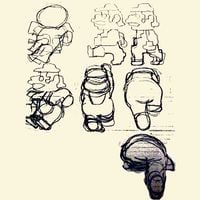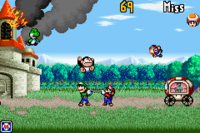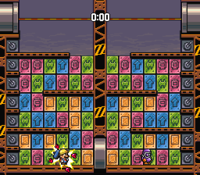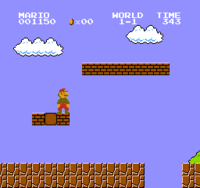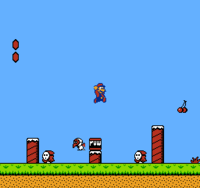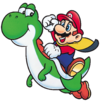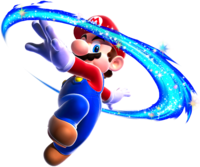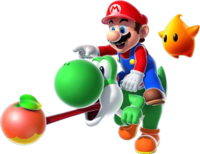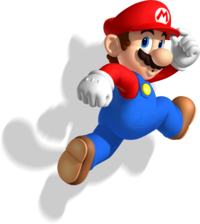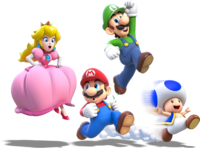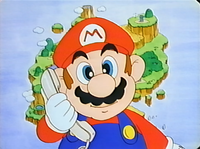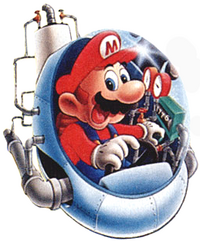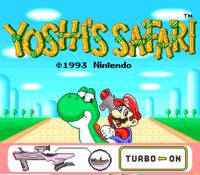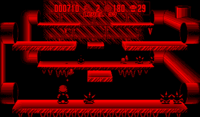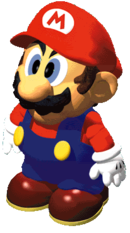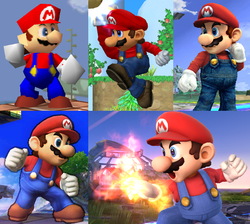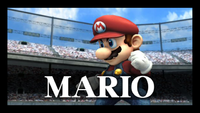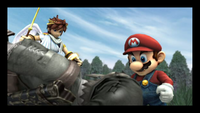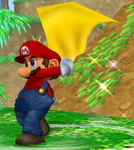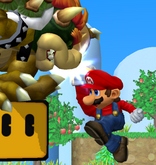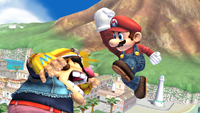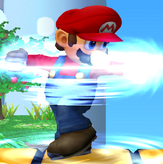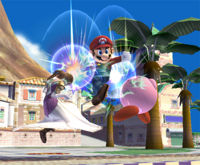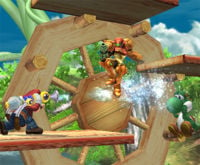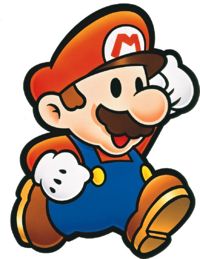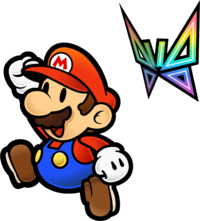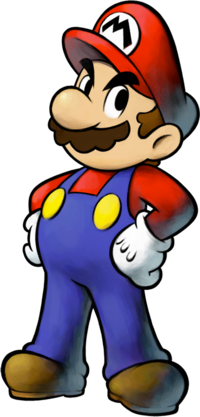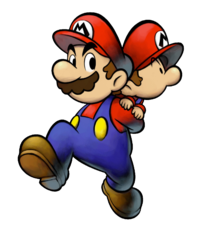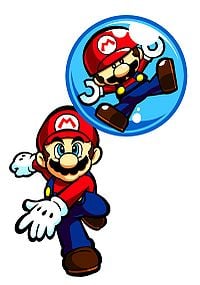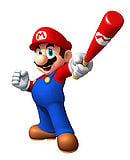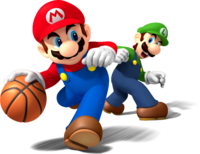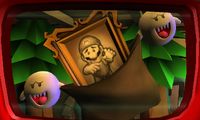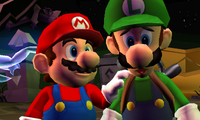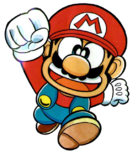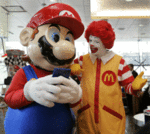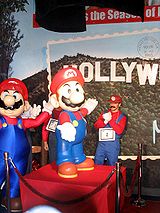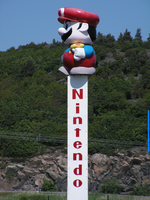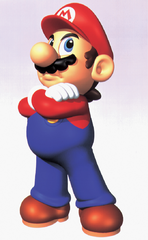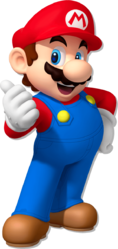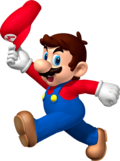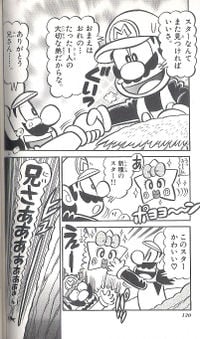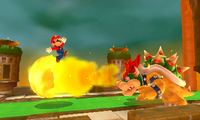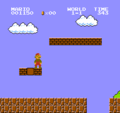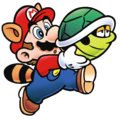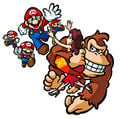Mario
Template:Character-infobox Template:Articleabout Template:Redirectshere
- “It's-a me, Mario!”
- —Mario, Super Mario 64
Mario is the main character and protagonist of the long-running and highly successful Mario series. He was created by Japanese video game designer Shigeru Miyamoto and also serves as the main mascot of Nintendo. Mario made his first appearance as the protagonist of the arcade game Donkey Kong, released in 1981. Since Super Mario Bros., his trademark abilities have been his jumping and stomping powers, with which he defeats most of his enemies, and his ability to change size and gain powers with a plethora of items, such as the Super Mushroom and Fire Flower. Games have usually portrayed Mario as a silent character without a distinct personality (Fortune Street is a notable exception). According to Nintendo's philosophy, this allows Mario to fit in many different genres and roles. In most games, he is the hero that goes on an adventure to save Princess Peach from the evil Bowser, but he has been shown doing other activities besides adventuring, such as racing and sporting.
Creation
Following the failure of Radar Scope in North America, Nintendo then-president, Hiroshi Yamauchi, requested Miyamoto's aid in converting unsold Radar Scope units into something that would sell well. Miyamoto conceived the concept of a love triangle and decided to make a game based on the Popeye character. He, however, was denied the rights for the Popeye franchise, so he decided to come up with a new idea using his own characters.
For use in his arcade game Donkey Kong, he created the character of Jumpman, who previously went under other names, such as Mr. Video, and originally, Ossan (the Japanese term for middle-aged man)[1]. This character was given red overalls and a blue shirt in order to make the arms more visible as well as a cap and moustache, as hair and a mouth were impossible to animate on the arcade system. [2] It is said that during the development for Donkey Kong Jr., the Jumpman character was renamed to Mario when an employee at Nintendo of America's office pointed out the similar physical appearances between Jumpman and Nintendo's Italian landlord, Mario Segale.[3][4][5][6]
History
Donkey Kong series
Donkey Kong
In Donkey Kong, Mario, known as Jumpman at the time, is a carpenter whose mission is to rescue his girlfriend Pauline from the clutches of Donkey Kong, who takes her to a Construction Site. With the one button of the game, the player can make Mario jump over obstacles. Mario also uses hammers as items. Jumping can be used to jump over obstacles only, not to destroy them, as is a prominent feature in later games.
Donkey Kong Jr.
In Donkey Kong Jr., Mario appears as the antagonist, having captured Donkey Kong and holding him in a cage. The protagonist Donkey Kong Jr. rescues his father in the end. Another game depicting Mario as the tamer of Donkey Kong is the Game & Watch title Donkey Kong Circus, in which Mario appears only in the background.
Donkey Kong Circus
Mario appears as the antagonist in the game Donkey Kong Circus. This is the first encounter between him and Donkey Kong. In the game, Mario is a circus owner who kidnaps Donkey Kong to star as his new attraction of his circus. In the end of the game, he is shown in a construction site where the first game begins.
Donkey Kong Hockey
Mario appears in the game Donkey Kong Hockey as the protagonist. His hockey shot is less powerful than Donkey Kong's but has more range than him.
Donkey Kong (Game Boy)
The game Donkey Kong on the Game Boy is not only a remake of the original Donkey Kong game, but also expands the game greatly with an additional nine worlds. These offer gameplay very different from both the original Donkey Kong game and the Super Mario series, mostly in the way that Mario is controlled. The story is similar to the original game: Mario's girlfriend Pauline is kidnapped by Donkey Kong, and Mario chases after Donkey Kong in order to save her. In the end, Mario defeats Donkey Kong and rescues Pauline.
Mario can perform a Handstand move which protects him from any objects falling on him from above. From the handstand position, Mario can also perform the High Jump. The game also features the Back Flip and ropes on which Mario can spin to catapult himself high in the air. Another essential part of his moveset, taken from Super Mario Bros. 2, is Mario's ability to pick up enemies and objects and lift them over his head to throw them. This is also one of the few Mario games in which Mario takes damage and can die from falling down too far. When he dies, the game displays Mario crumbled and sometimes charred, with a halo over his head.
In most stages, Mario has to find the key and take it to the locked door in order to proceed to the next level. As long as Mario holds the key, he has an additional hit point, although he loses the key when being hit. He uses Hammers as seen in the original Donkey Kong and constructs temporary Ladders and Roads in order to pass through the levels. Other levels are boss fights against Donkey Kong Jr. and Donkey Kong.
Many of Mario's moves and objectives are carried over to the formerly-planned sequel, Mario vs. Donkey Kong.
Donkey Kong Country 2: Diddy's Kong Quest
Mario makes a cameo appearance in Donkey Kong Country 2: Diddy's Kong Quest. He appears at the end of the game as one of Cranky's Video Game Heroes, along with Diddy Kong, Link, and Yoshi. With 39 DK Coins in the original and 67 in the Game Boy Advance version, he is the top video game hero.
The Saturday Supercade
Mario appears in several episodes in The Saturday Supercade, which was his first television show. His personality on the show was of a heroic person whose goal was to capture Donkey Kong. He was voiced by Peter Cullan, who was the first person to give Mario any kind of voice.
Mario Bros.
After Donkey Kong, Mario is given his own starring series, beginning with the arcade game Mario Bros. in 1983. Only Mario's physical appearance is taken from earlier titles; Mario is now a plumber working in the sewers of New York and fighting an endless number of creatures, such as Shellcreepers and Sidesteppers. Unlike later games, Mario can jump against the ceiling of a platform from below to stun all enemies walking above it. When Mario approaches the stunned enemies, he kicks the enemies out the screen, rendering them defeated. In the two-player mode, the second player plays as a palette swap of Mario. This character is introduced as Mario's brother Luigi, who wears green, whereas Mario wears red.
Game & Watch series
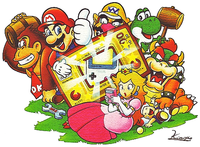
Mario has appeared in several Game & Watch games including Mario's Bombs Away, Mario's Cement Factory, Mario the Juggler, and Super Mario Bros. He also appeared in four installments of remakes marketed as the Game & Watch Gallery series, and he later appeared in Game & Watch Collection.
In the Game & Watch version of Donkey Kong. The objective is the same as in the arcade version, but Mario must trigger a level, which causes a hook to appear. If Mario grabs the hook, a peg is removed, and he is transported to the starting point. If Mario misses, he falls and loses a life. If Mario removes all the pegs, he defeats Donkey Kong.
In Mario Bros. (which is unrelated to the one in the arcade), Mario and Luigi must cooperate and put pallets on a delivery truck. They have to use conveyor belts to send the package to each other. If they drop a pallet, their boss yells at them. If they drop three pallets, the game is over. In Game & Watch Gallery 3 and in Game & Watch Gallery 4, Wario is the boss, and Bowser periodically appears and reverses the conveyor belt directions. Cakes replace pallets in the game.
Mario is featured in Mario the Juggler, a Game & Watch game based on the very first one, Ball.
Mario must safely deliver bombs in Mario's Bombs Away, avoiding oil spills and torches.
In Mario's Cement Factory, Mario must move cement from hoppers into cement trucks by putting them on conveyor belts. The conveyor belts can hold only three hoppers. If the hopper overflows, some cement can land on a worker, making Mario lose a life. Mario can move by using an elevator, but if he moves when the elevator is not there, he falls and loses a life. If Mario stays in the elevator for too long, he can be crushed, or he call fall and lose a life; there are safe zones to circumvent this. In the remake in Game & Watch Gallery 4, Yoshi and Toad appear as background characters. Boo can appear and interfere with the work. Mario can fall from the elevator, but when he touches the bottom ground, he gets a miss.
Super Mario Bros. in the Game & Watch series plays almost the same as the original game in the SNES. This version, however, is simpler and shorter.
Mario has also appeared in various heavily toned-down games on the Game Watch, a wristwatch that can tell time and play games. The games arew based on Super Mario Bros., Super Mario Bros. 2, Super Mario Bros. 3, Super Mario World, Super Mario Kart, and Donkey Kong.
In the modern games of Game & Watch Gallery remakes, Mario also takes some roles previously taken by other characters. Other times, he is a non-playable character. In Fire, for instance, he and Luigi rescue Toads, Yoshis, and Donkey Kong Jr.s from a fire. In another example, in Chef, Peach must cooperate with Mario and Luigi to feed Yoshi. Mario or Luigi throw the food, and Peach can catch them in her pan.
Mario Golf series
Since 1984's Golf, Mario has appeared as a playable character in all games of the Mario Golf series. In Mario Golf for the Nintendo 64, Mario appears with Luigi in the 18th Mario Power Star hole. His drive is 270 yards and his shot is Draw. He must be unlocked in single player mode, but he is default in multiplayer mode. In Mario Golf: Toadstool Tour, Mario reappears as a default character in all modes. His draw is 212 (280 with a star) with a high, straight trajectory. He has a strong impact and spin, but relatively weak control. When he hits a Nice Shot, the ball is encased in flames.
Mario has also appeared in the opening in Mario Golf: Toadstool Tour. Mario unintentionally interferes with Bowser's chasing Wario and Waluigi by hitting Bowser's hand with a golf ball. Bowser drops the Bob-omb on Wario and Waluigi, creating an explosion in the structure. This surprises Mario, Luigi, Princess Peach, and Princess Daisy. At the end, Bowser, Wario, and Waluigi growl at a confused Mario.
Wrecking Crew series
Wrecking Crew
In 1985's Wrecking Crew, Mario and Luigi appear as workers on a demolition site, similar to Jumpman working as a carpenter in Donkey Kong. They use hammers similar to those previously seen in Donkey Kong against Foreman Spike. Unlike its Japan Only "sequel", Wrecking Crew '98, the game has no specific plot. In this game, Mario wears a helmet, shoes and dark red overalls. Mario faces Gotcha Wrenches, Eggplant Men, and Foreman Spike. In this game, Mario must break all the stone walls before the enemy can. Mario can defeat enemies by trapping them in drums. Foreman Spike can attempt to break blocks himself or push Mario, but Mario can hit him with his hammer and cause him to fall. If Mario stays too long, a Fireball appears to hinder his progress.
Mario reappears in Vs. Wrecking Crew, an arcade game for the Nintendo Vs. system. The game plays similarly to the original with the addition of simultaneous 2-player mode, where Mario and another player compete.
Wrecking Crew '98
In Wrecking Crew '98, Mario comes back to the Mushroom Kingdom from one his quests and discovers that it is overrun with many of Bowser's new fortresses. Foreman Spike also makes a reappearance, this time helping Bowser. The result of all this construction is a withering Mushroom Kingdom, so Mario uses his hammer to destroy all the fortresses and save the land from Bowser once again.
Unlike in the first game, Mario can hinder his opponent's progress by raining panels on them. To clear the stage, Mario must demolish blocks or arrange three consecutive panels vertically or horizontally. If four or more panels are aligned, Mario can rain panels onto his opponent. If he clears the field, he receives a Mushroom, boosting his offensive combos toward his enemy.
Super Mario series
Super Mario Bros.
Since Super Mario Bros., Mario is portrayed living in the Mushroom Kingdom. In the game, Mario's objective is to rescue Princess Toadstool (later known as Peach) from Bowser, the King of the Koopas. The game is the first in the series in which regular enemies such as Goombas can be defeated and Koopas can be stunned by stomping on them from above. Mario can also gain power-ups and coins from jumping against Question Blocks and Brick Blocks. Mario begins the game as Small Mario, who loses a life from any enemy attack. By using Super Mushrooms, Mario grows into Super Mario, who has an additional hit point (reverting to Small Mario after being hit). Super Mario has access to the Fire Flower, which lets him throw Fireballs that can knock out enemies such as Koopas or False Bowsers. Mario can also become invincible for a short amount of time with the Star.
Mario's role and powers remain mostly the same in all entries to the series except for Super Mario Bros. 2. While new power-ups and moves are introduced, there is no deviation from the basic formula; Mario's basic appearance is unchanged and his personality remains unwritten. Despite this, Mario in the later games has adapted this depiction. Mario's eye color, mustache shape, hair style, cap shape, and face shape are all derived from Super Mario Bros..
Super Mario Bros.: The Lost Levels
Mario makes another appearance as the main protagonist of the very similar game, the sequel, Super Mario Bros.: The Lost Levels (sold in Japan as Super Mario Bros. 2 but as an entirely different game from the Super Mario Bros. 2 game shown below). Directly after Bowser's defeat and the Princess's rescue, Bowser had kidnapped her again and invaded the Mushroom Kingdom. Mario and Luigi has to rescue Princess Toadstool from Bowser the second time by traveling in new various different lands of the Mushroom Kingdom defeating more of the Koopa Troop and the False Bowsers.
Mario's traction and jumping height remain the same, while those of Luigi are changed to differentiate him more from Mario. Luigi jumps higher than Mario but has less traction, so he takes some time to halt after running. Luigi is also now a completely separate character from Mario, so the story of the game has two alternate versions.
Super Mario Bros. 2
Super Mario Bros. 2 is a deviation from the standard formula of the series. The game is entirely based on the Japanese game Yume Kōjō: Doki Doki Panic. In the story of Super Mario Bros. 2, Mario is mentioned to having an odd dream one night. The fairy like beings from the land of Subcon inform him that King Wart has taken over the land of Subcon and that they needed Mario's help to defeat Wart. However, after awakening from his dream, Mario simply dismisses the dream and returns to sleep. The next day, Mario along with his friends Luigi, Princess Toadstool, and Toad decide to go on a picnic. However, while searching for a proper place, Mario and his friends notice a strange cave and decide to explore within it. After entering the cave, the four friends are transported to Subcon. Remembering his dream, Mario decides to save Subcon from Wart and his army of the 8 bits and calls on his three other friends to aid him on his journey. Throughout their adventure, Mario and his friends defeat many of Wart's members, including Birdo and Mouser. Eventually, Mario and his three friends confrons Wart himself to a battle. After defeating Wart, Mario and his friends rescue the Subcon fairies and ultimately the land of Subcon.
While the four heroes celebrate their victory, Mario is seen to be awakening during the end of the game, implying the message that the whole adventure is simply a part of Mario's dream. The spiritual sequel, BS Super Mario USA, explains that Subcon is a dream world, and while Mario and the others initially thought it is all a dream, when they are called back into the world to save it from Wart again, they learn the truth about the realm. This also explains how various characters and species originating in Super Mario Bros. 2 (such as Birdo and Shy Guys) reappear outside of Subcon in later games.
In contrast to the other characters, Mario is a well-balanced character with no special abilities in Super Mario Bros. 2 and its sequel, which has the same gameplay mechanics. The gameplay of the two games is vastly different than other Mario titles: enemies can no longer be defeated by stomping them, and Mario gains the power to pick up enemies, lift them over his head, and throw them. This feature is later reused in the Game Boy version of Donkey Kong and the Mario vs. Donkey Kong series of games.
Super Mario Bros. 3
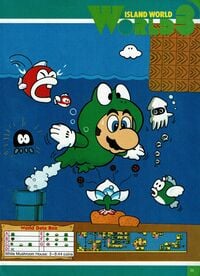
In Super Mario Bros. 3, after Bowser has invaded again, Mario and Luigi travel through eight kingdoms, in which the kings have been transformed into creatures by the Koopalings. During Mario's quest, he is repeatedly sent letters by Princess Toadstool, who encloses power-ups for him. Eventually, Toadstool is kidnapped, and the Mario brothers save her from Bowser in the end. Super Mario Bros. 3 introduces a plethora of new power-ups aside from the Fire Flower, including Super Leaves, Tanooki Suits, Frog Suits and Goomba's Shoes. He also encounters new enemies, such as Thwomps and Boos.
Super Mario World
Super Mario World introduces Yoshi as a sidekick character to Mario. Mario can ride Yoshis and so gain varying new powers. Mario meets Yoshi on a holiday in Dinosaur Land, where Bowser kidnaps Toadstool again, and it is up to Mario and Luigi, to rescue her again. Super Mario World is the first Mario game to have a second jump button for a different jump - the Spin Jump- with which Super Mario can destroy Rotating Blocks from above or jump off Yoshi's back. Mario can use Cape Feathers to turn into Cape Mario, allowing him to take off from the ground and stay in the air for quite a while. Mario can also use Grab Blocks and throw them at enemies or obstacles.
Mario and Luigi defeat the Koopalings in their castles, rescue the captured Yoshi Eggs, and defeat Bowser in the Valley of Bowser, rescuing Toadstool and taking her home to Yoshi's Island.
Super Mario 64 / Super Mario 64 DS
In Super Mario 64, Mario is invited to have a cake with Princess Peach at her castle but finds the castle taken over and Peach kidnapped by Bowser when he arrives there. When facing off against Bowser, Mario grabs his tail and spins him around to throw him off of the fighting platform. After being rescued, Peach kisses Mario and bakes him the cake.
Mario is in a three-dimensional environment. Mario has additional moves. He can now crouch and combine ducking with jumping. Pressing ducking and jumping while standing results in a backwards somersault, and doing it while running results in a Long Jump. Mario can jump higher when doing consecutive jumps (the Triple Jump), and a side somersault can be performed by quickly changing direction. Wall jumps, another first, can also be performed. Mario has more offensive options: he can punch, kick, slide attack, and use the Ground Pound. Super Mario 64 has also introduced the health meter, so Mario can take more hits before losing a life. Mario can receive special abilities by activating Exclamation Mark Blocks, including the Wing Cap or the Metal Cap. Super Mario 64 is also the first game to limit the time Mario can spend underwater; his health meter empties the longer Mario stays underwater. Mario's health can be refilled with coins or water bubbles or by surfacing on the water. Mario can also take falling damage from dropping from high elevations. Mario can also lose his hat in the game, and until he gets it back, he will take more damage and his health depletes faster underwater.
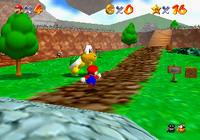
In the game's remake, Super Mario 64 DS, Mario is once again invited to Peach's castle for cake, along with Wario and Luigi. However, some time after entering, Bowser overtakes the castle. The trio is thrown behind locked doors, Mario being sealed away by Goomboss, who keeps the key to his door. Yoshi, who has avoided capture by sleeping on the castle's roof, is able to find a portrait of Mario in Peach's room and finds Goomboss. After defeating him, Yoshi unlocks Mario's door with the key he receives.
From then on, Mario is an additional playable character. He is required to rescue Luigi (while Luigi is needed to rescue Wario). Mario is also required to enter the final level to rescue Princess Peach. Mario has average stats, with decent power, speed, and jump. His special ability is the balloon floating power gained by the Power Flower. Mario can still use the Feather, this game's equivalent to the Wing Cap, which gives him more abilities than the other characters. Mario is also the only character that can wall jump. Other characters can transform into Mario, gaining his appearance but not his voice, by putting on Mario's Hat. Mario himself can transform into Luigi and Wario this way but not into Yoshi. The game's story is otherwise identical to that of the original game.
Super Mario Sunshine
Super Mario Sunshine features a more advanced introduction and storyline background than usual in games of the Super Mario series. Mario, Peach and Toadsworth travel to the tropical island of Isle Delfino to have a vacation. However, upon arriving on the Delfino Airstrip, they notice some type of Goop is covering half the area. Mario, by request from Toadsworth for help, comes across F.L.U.D.D., and, with his help, destroys the Polluted Piranha Plant and Goop Generator, cleaning the airstrip. However, soon after, the police arrive and take Mario to a courthouse on the main island.
Mario is then placed on trial against the citizens of Isle Delfino, represented by a Pianta Attorney. During the trial, the attorney explains that Isle Delfino is covered in Goop by an unknown entity, though descriptions from various unknown eyewitnesses have proven that Mario has vandalized Isle Delfino. Peach and Toadstool tried objecting against the attorney, but the judge overruled the objection quickly, sentencing Mario to clean the island of the Goop as community service while returning the island's power by collecting Shine Sprites, the island's source of sunlight.
Shadow Mario soon captures Peach, taking her to Pinna Island. From there, Mario uses a cannon in Delfino Plaza to come after her, and, after chasing Shadow Mario through the island's theme park, arrives at a lake, where Shadow Mario unveils Mecha Bowser, a huge Bowser-like robot. However, he defeats the robot by using Water Rockets. It is here that Shadow Mario revealed himself to be Bowser Jr., Bowser's eighth and newest child. Bowser Jr. then reveals that he had taken Peach because Bowser has told him that Peach is his mother and that she is "kidnapped by a bad man named Mario..." Mario, Peach, and F.L.U.D.D. also learn that Bowser Jr. has planted the Graffiti so Mario can be sent to prison, but it fails. Bowser Jr. then escapes, and he and Peach fly to Corona Mountain.
Mario later arrives at the top of the mountain, where Peach, Bowser, and Bowser Jr. are sitting in a hot tub. The interruption enrages Bowser, and he begins to fight Mario. However, despite having help from Bowser Jr., who is firing Bullet Bills from his raft, Mario still manages to ground-pound all five sections of the hot tub, causing it to flip, sending Mario, Peach, Bowser, and Bowser Jr. falling to the ground. Mario and Peach land on an islet west of Delfino Plaza, where Mario also finds F.L.U.D.D lying on the ground, highly damaged from the fall and stress of the battle. F.L.U.D.D then asks if he had truly assisted Mario before shutting off. The two then watch as the final Shine Sprite falls to the Shine Gate, restoring light to the island.
Mario and Peach are then seen at Sirena Beach, Mario still upset his loss of F.L.U.D.D. Both then turn around to see the Toads that came with them to the island, one holding F.L.U.D.D., who is now fixed, and says, "The vacation starts now!"
The game removes most jumping, punching, and kicking abilities of the previous game and replaces them with F.L.U.D.D.'s powers. Mario can spray water at enemies and clear Graffiti. Expansion Nozzles for F.L.U.D.D. can make Mario hover in the air for a short while, make him run at a turbo speed, or rocket high up in the air, although Mario can hold only one Expansion Nozzle at a time. Water for F.L.U.D.D. can be refilled at any body of water in the game or with Water Bottles. Mario can also ride Yoshis. In the Secret Levels of the game, Shadow Mario takes F.L.U.D.D. away from Mario, leaving him only with his basic jumping abilities and the Ground Pound to beat the stage. When Mario loses his cap in Super Mario Sunshine, he takes damage from the sun.
New Super Mario Bros.
New Super Mario Bros., released in 2006, is a game very similar to earlier Super Mario Bros. games by design. Mario's role is almost identical here. The beginning of the game shows Mario and Peach taking a walk outside of Peach's castle, when lightning hits the castle. Mario quickly runs off to check it, while Peach stays behind and is thus kidnapped by Bowser Jr. The lightning bolt at the castle was just a distraction for Mario. Throughout the game, Mario chases Bowser Jr. in order to save Princess Peach.
Mario's powers still include throwing Fireballs when having a Fire Flower, and this time also size-changing effects induced by the Mega Mushroom and the Mini Mushroom. The Mega Mushrom lets Mario grow to a giant size, being able to crush all enemies and obstacles like pipes, while the Mini Mushroom has Mario shrink to a tiny size, which gives him access to new areas.
Mario first faces Bowser at the first of the eight castles, where Mario presses a switch, causing Bowser to fall into the lava. However, Bowser survives as a skeletal version of himself, known as Dry Bowser. Dry Bowser is fought again in the eighth castle, although he is defeated.
Mario eventually arrives at Bowser's Castle, where Peach is taken after Mario defeats Dry Bowser. Here, Bowser Jr. throws Bowser's bones inside a bubbling pot, reviving him as a somewhat larger version of Bowser. However, despite his larger size and extra strength, Bowser is still beaten when Mario presses the switch, causing Bowser and his son to fall into a pit and freeing Peach.
Super Mario Galaxy
Super Mario Galaxy returns most of the jumping mechanics present in Super Mario 64 missing in Super Mario Sunshine. The game also added new powers, including the Star Spin (which replaces Mario's offensive moves in Super Mario 64) and the Wii pointer, which can be controlled independently from Mario. The Wii pointer allows players to shoot enemies or grab Star Bits without controlling Mario.
In the game's story, Mario is invited to the Star Festival by Peach, but her entire castle is abducted by Bowser during the festival, and Mario is thrown into outer space as part of Bowser's plot to create an empire at the center of the universe, with Peach at his side. When recovering in the Gateway Galaxy, Mario is asked by Rosalina to rescue the Power Stars in order to save Peach. Mario is given the Baby Luma, who allows him to Star Spin and travels with him to all locations. Throughout the game, Mario also receives letters from Peach, who sends him 1-Up Mushrooms.
After several encounters with Bowser, Mario defeats him in Bowser's Galaxy Reactor. However, the only thing holding the star they fought in together is the final Grand Star. When Mario rides away on the Grand Star, Bowser's star explodes, creating a black hole. Before Mario can be sucked in, he is seen shocked when the Baby Luma sacrifices itself to prevent Bowser's black hole from consuming everything around it, including Mario and Princess Peach's castle. After a big explosion, Mario reappears in an unknown location in front of a large, floating Rosalina who speaks to him. Mario then awakens in a restored world, near Peach's Castle. He also sees Bowser and Princess Peach awaken, intact.
New Super Mario Bros. Wii
Mario's role and abilities stay identical in the sequel New Super Mario Bros. Wii, although there are a few added power-ups, such as the Propeller Mushroom and the Penguin Suit, and the story is changed slightly. In the cutscene at the beginning of the game, Mario, Luigi, and many Toads, including Blue Toad and Yellow Toad, are celebrating Princess Peach's birthday when a cake suddenly walks into the castle. When Peach moves closer to the cake, Bowser Jr. and the Koopalings jump out of the cake and throw it onto Peach. Mario, Luigi, and the Toads then give chase, and Mario once again fights his way through eight worlds in his attempt to rescue Peach. After the Mario rescues Princess Peach, the princess tells Mario about secret World 9, extending his adventure.
Super Mario Galaxy 2
The game Super Mario Galaxy 2 is a sequel to Super Mario Galaxy. Before arriving at the castle, Mario finds Luma lying on the ground. Luma then flies into his cap again, giving him his old spinning ability. However, when Mario arrives at Princess Peach's castle, a Giant Bowser kidnaps Peach. Mario gives chase, using a Launch Star.
After finding a star in the first Galaxy, Mario finds a small planetoid that a group of Lumas, led by Lubba, are using to travel around. Lubba then explains that earlier, Bowser found them, took their star power, and left the ship in disrepair. The crew of Lumas then use their power to transform the ship, giving it the appearance of Mario's head, and it is named the Starship Mario. Being named the captain, Mario flies off to collect Power Stars in order to reach Bowser and Princess Peach.
Aside from additional power-ups and the addition of Yoshi, the gameplay is identical to the first Super Mario Galaxy game. Mario defeats Bowser and saves Peach in the end. Rosalina and her Comet Observatory appear before Mario and Peach. Rosalina thanks Mario for watching over the Luma that he has found, and the Luma returns to the Comet Observatory along with Mario's hat. Mario and his companions return to the Mushroom Kingdom.
Super Mario 3D Land
Mario appears in Super Mario 3D Land for the Nintendo 3DS. He uses several classic power-ups, notably, the Tanooki Suit from Super Mario Bros. 3. He once again saves Princess Peach from Bowser's clutches.
After a storm, all the Tanooki Leaves are blown from the Tail Tree outside Peach's Castle. The next day, Mario and three Toads investigate the scene when they notice a floating letter. They open it to discover that Bowser kidnapped Peach while she checks the damage to the tree. Mario and the Toads then run to rescue her. During the adventure, Mario battles several enemies old and new, including Boom Boom and Pom Pom. While running through the worlds, Mario receives letters from Peach to learn about her situation. Mario also encounters False Bowsers throughout the adventure.
Mario fights Bowser at Bowser's Castle, activating the switch on the other side of the bridge and sending Bowser into the lava. The area beside the castle contains only a cage lying on its side, however. He enters a door and finds Peach, but, upon running over to her, he finds out that it is only a wooden cutout. Bowser then emerges, carrying the real princess, and flees to his second castle.
After heading through another level, Mario reaches Bowser's second castle and the princess, this time tied to the flagpole. Bowser then appears, and the two begin their battle. This time, Mario has to navigate an obstacle course to get to the bridge and eventually the switch at the end. He pushes this, sending Bowser into the lava below. Bowser then emerges from the lava, however, and Mario has to reach another switch in order to actually defeat him. Pushing the switch once again sends Bowser falling into the lava below once more. Mario then reappears back at the flagpole, and frees the princess. Mario, along with three Toads, then use Super Leaves to get themselves and the princess back home.
Sometime after that, Mario receives a letter from Luigi, depicting Luigi in captivity. Mario runs through Special 1 and frees Luigi from Dry Bowser. Then, Peach is captured by Bowser again. Mario goes back to his castle and defeats him again. Once Mario gets 5 Stars in his profile, the level Special 8-Crown is unlocked. There he faces Boom Boom and Pom Pom for the last time. When they are defeated, a giant "THANK YOU" is made out while Toads surround the final Goal Pole of the game.
New Super Mario Bros. 2
Mario once again appears as the main protagonist of New Super Mario Bros. 2. In this game, Mario can once again become Raccoon Mario, first seen in Super Mario Bros. 3. Gold Mario (as well the Gold Flower) is introduced, as Mario's newest form. In this form, he can throw fireballs which transform solid objects (blocks) into coins for him to collect. It is also the introduction of White Raccoon Mario, a form obtainable from Invincibility Leaves gotten from Assist Blocks. The form gives Mario the power of invincibility and all of the abilities of Raccoon Mario.
In the game, Mario and Luigi are visiting Princess Peach, and leave her Castle in Tanooki form, with the princess waving them off, to collect Coins in the sky. As soon as they land, the Koopalings appear in the Koopa Clown Car and slam into the ground, causing the brothers to lose their raccoon powers. They reveal that they have taken Princess Peach once again, and the brothers give chase. As they travel through the six worlds, the Bros. must find secret worlds, battle Reznors, who make a return, the Koopalings, and search for coins. At the very end they confront Bowser, who is powered up by the Koopalings after his first defeat. However, in classic Mario style, the Mario Bros. use a switch to drop Bowser into a pit. Peach is rescued and the brothers return home.
There is another mode in the game, Coin Rush, in which Mario must collect as many coins as possible in three random courses within the time limit and without getting hit once. There are + Clocks scattered throughout the courses, and Mario gets more time by finishing a course. Regular activities, like collecting power-ups, defeating enemies and getting to the top of the flagpole are all rewarded with additional coins.
New Super Mario Bros. U
Mario appears again as the protagonist in New Super Mario Bros. U. Once again, he must save the Mushroom Kingdom from Bowser and his minions as he travels with his allies Luigi, Blue Toad and Yellow Toad, and his new allies Miis. After Bowser kidnaps Peach, Mario and his allies crash into a tree, releasing Super Acorns. He gets a new form, Flying Squirrel Mario when he collects them. In this form, he can glide and cling to walls. The upgraded P-Acorn allows him to fly indefinitely. His old powerups, including, but not limited to the Mushroom, Fire Flower, Ice Flower return. The Penguin Suit and Propeller Suit from New Super Mario Bros. Wii also return, but they are found only in certain Toad Houses and in Challenge Mode.
In this game, Mario discovers Baby Yoshis that aid him in his adventure by providing light, emitting bubbles, or floating. During his adventure, he encounters new enemies alongside the old enemies, including, but not limited to Waddlewings, Nabbits, and Goombrats. To save Princess Peach, Mario must travel to a Koopaling's airship and defeat that Koopaling to proceed. Meanwhile, Bowser modifies Peach's Castle according to his tastes. When Mario finally arrives at Peach's Castle, it is conquered, and he must enter the modified castle to meet Bowser and rescue Peach.
Unlike in New Super Mario Bros. Wii, when Mario collects 99 lives, he keeps his hat.
In the downloadable content New Super Luigi U, Mario himself does not appear at all, the first time this has occurred in the entire Super Mario series. However, in the opening sequence, his hat appears on the table. Additionally, at the beginning of the the Frosted Glacier level Broozers and Barrels, a snowman with Mario's face and a hat with his "M" on it can be seen.
Super Mario 3D World
Mario returns in Super Mario 3D World, alongside Luigi, Princess Peach and Toad. Similarly to Super Mario Bros. 2, he is an all-around character, unlike the other three characters, who each has a special ability. After Bowser has kidnapped the Sprixie Princesses, Peach jumps in the pipe that leads to Sprixie Kingdom while Mario, Toad, and Luigi follow her shortly. There, they cooperate on their adventure to reach Bowser. During his adventure, Mario encounters new items, most notably, the Super Bell, which transforms him into Cat Mario. He also encounters new enemies, such as Cat Goombas and old enemies, including Chargin' Chucks. Boom Boom and Pom Pom also reappear to hinder Mario's progress while new bosses, such as Hisstocrat are additional impediments. Once Mario and his teammates reach the end of World Castle, the seventh world, Bowser retreats into another world, the amusement park in World Bowser. Once Mario and his friends finally reach Bowser, Bowser transforms himself into Meowser and climbs a huge tower. Mario and his friends then hit the large POW block at the peak of the tower, defeating Bowser, transforming him into a large firework. They then proceed to rescue the Sprixie Princesses. They then use a clear pipe to return to Mushroom Kingdom.
Super Mario Land series
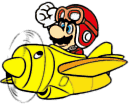
In Super Mario Land, Mario travels to Sarasaland to rescue the land's princess Daisy from the alien Tatanga. Mario's powers in the game are limited to Superball Mario, in which he can shoot balls that ricochet off walls, as well as the Marine Pop, a submarine, and the Sky Pop, a helicopter, each in a special scrolling stage. When he rescues Princess Daisy, Mario is kissed by her, and the two fly off in a spaceship.
Super Mario Land 2: 6 Golden Coins introduces a new antagonist to Mario named Wario. Wario usurps Mario's Castle while Mario rescues Princess Daisy in Sarasaland (the events of Super Mario Land). The player's objective here is to regain control of Mario's castle, now known as Wario's Castle. Mario gains more powerups this time, including a Fire Flower and the Carrot. The Fire form has a slightly different appearance; Mario wears a small feather on his hat. the carrot transforms Mario into Rabbit Mario, which allows him to slow his descent or have him hover. When Mario encounters several enemies and bosses by traveling through zones rather than worlds. When he finally reaches Wario, Wario attempts to use powerups, transforming him into Fire Wario and Rabbit Wario, but Mario eventually prevails and takes his castle back.
Although Wario Land: Super Mario Land 3's title has Mario's name in it, Wario is the protagonist of this game. Mario is mentioned as one of Wario's motivations to go on a treasure hunt in the game's manual. Mario himself makes a small appearance at the end of the game; he steals a Princess Peach statue from Wario.
DIC Cartoons
In the Mario cartoons produced by DIC Entertainment, Mario and Luigi are shown to be plumbers from Brooklyn. According to the first two animated series, Mario and Luigi arrived in the Mushroom Kingdom while out on a house call; they are shown working on a bathtub in an old woman's house when they are suddenly sucked down the drain, transporting them to the Mushroom Kingdom, where they save Princess Toadstool from King Koopa for the first time. The series depicts Mario as the pasta-loving older brother of Luigi.
The Super Mario Bros. Super Show!
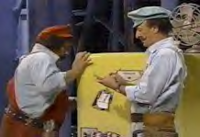
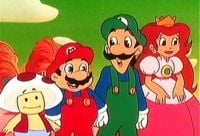
The Super Mario Bros. Super Show! shows both Mario and Luigi's lives in the real world and their lives in the Mushroom Kingdom, through both live-action and animated episodes. In the live-action portion of the show, Mario and Luigi are plumbers living in Brooklyn, working from Mario Bros. Plumbing, their basement workshop doubling as their home. They are shown as being financially unsuccessful, barely being able to get by; in some segments Mario is shown to have disdain for his life; in the episode "Baby Mario Love" Mario is shown complaining about his life being dull, not having any glitz or glamour.
In the animated segments, Mario and Luigi are traveling across the Mushroom Land with Toad and Princess Toadstool, searching for anyone or anything that can both rid the kingdom of King Koopa and send Mario and Luigi back home to Brooklyn. According to the first episode, "The Bird! The Bird!", they begin their quest shortly after Mario and Luigi have saved Princess Toadstool after arriving in the Mushroom Kingdom.
The Adventures of Super Mario Bros. 3
- For a complete list of the episodes of The Adventures of Super Mario Bros. 3 that Mario has appeared in, see List of The Adventures of Super Mario Bros. 3 episodes featuring Mario.
The Adventures of Super Mario Bros. 3 follows after the events of The Super Mario Bros. Super Show! This series of episodes are based on Super Mario Bros. 3. Unlike in the previous series, this one has Mushroom Kingdom in a more peaceful state. Mario has more enemies to fight, most notably, the Koopalings. The only episode Mario does not appear in is Life's Ruff.
Super Mario World
- For a complete list of the episodes of Super Mario World that Mario has appeared in, see List of Super Mario World episodes featuring Mario.
The Super Mario World television series is a continuation of the previous series, The Adventures of Super Mario Bros. 3. This time, the episodes focuses loosely on the video game Super Mario World with added characters, the most prominent, Yoshi, the Cave People, and Oogtar. Mario appears in every episode of the Super Mario World television series as one of the main protagonists.
Super Mario World: Mario & Yoshi's Adventure Land
Mario is one of the main characters in the interactive anime OVA Super Mario World: Mario & Yoshi's Adventure Land. The video follows the story of Super Mario World rather closely, though it is quite condensed. Mario leads a group on a quest to save Princess Peach from Bowser. He is shown to be the bravest of the group, with Luigi and Yoshi less so. He often calls the viewer to ask questions.
Edutainment games
Mario Teaches Typing
Mario plays a role by helping children type in both games, Mario Teaches Typing and Mario Teaches Typing 2. By typing correctly, players enable the game to advance. Mario Teaches Typing 2, the sequel, has another story. Mario and Luigi find a Magical Typewriter. The note attached to it explains that it is essential to beat Bowser. If one types the correct sequence into the scroll, a spell is cast and defeats Bowser. If it is used incorrectly, however, the typewriter will self-destruct. Mario attempts to type, but he fails, and the typewriter explodes, sending its pieces to various regions. The two adventure, retrieving the pieces while improving their typing abilities, eventually restore the typewrite and cause a giant typewriter to fall on top of Bowser's castle.
Mario Is Missing!
The 1992 game Mario Is Missing! was the first game in the Mario Discovery Series[7] of Educational Games and set the Mario characters in Earth. When hearing of Bowser's plan to flood the Earth by melting Antarctica's ice with hair dryers, Mario, Luigi and Yoshi head to Bowser's castle in the Antarctic. Mario is captured, although his capture varies between versions of the game.
In the DOS version, Mario enters the castle alone, as Luigi is too scared to follow. Mario meets Bowser, who is in a butler disguise, and accepts candy from him, despite Luigi's warning not to take candy from strangers. Bowser uses this as a distraction to trap Mario in a net. Despite his captured status, however, Mario in that version will nonetheless manage to give contact to Luigi to guide him to the continents to stop Bowser's plans, as well as update him on the situation. Over the course of the game, Mario tells Luigi that he admitted to Bowser that he has a fear of the dark, which strained communication since Bowser is threatening him with his fear. In the NES version, Mario is captured outside in the snow by a Koopa with a bag. In that version, he also reacts angrily to the title shortly before being captured by the Koopa. In the SNES version, Mario traps into a pitfall outside the castle.
The game centers around Luigi, who rescues Mario from Bowser in the end.
Super Mario Bros. & Friends: When I Grow Up
Mario appears in various scenes of the virtual coloring book, Super Mario Bros. & Friends: When I Grow Up. He and various other Mario characters (and Link) are shown in various occupations.
Mario's Time Machine
In Mario's Time Machine, Bowser uses a time machine to steal various artifacts from different time periods of human history in order to display them at his museum. Mario goes on a mission to return all objects of Bowser's museum to their original time periods in order to prevent history from being altered. Additionally, Mario had to rescue Yoshi from Bowser in the NES version of the game. Mario's Time Machine is one of the few games in which Mario talks.
In the NES version, the player has to play an altered version of Mario Bros. to defeat Koopa Troopas, who drop the stolen objects when defeated. Mario then has to travel back in time to return the objects to their proper place in a side-scrolling mission.
In the SNES version, Mario has to pick a stolen object from the museum and then go to a "Time Surfing" level to collect enough Mushrooms to make a time jump, then return the objects to their proper place.
Mario's Early Years! series
Mario has appeared in Mario's Early Years! series, which consists of three games. Mario, by traveling to different worlds, teaches basic learning skills to younger players such as counting, recognizing shapes, and basic spelling. Mario is controlled by a cursor interacting with an object.
Mario's FUNdamentals
Mario has also appeared in Mario's FUNdamentals. Here, Mario plays several games with younger players such as "Go Fish", "Checkers", "Backgammon", "Dominoes", or "Yahtzee". This game is also the first game where Charles Martinet, the current voice actor for Mario, provided voices for Mario.
Mario Kart series
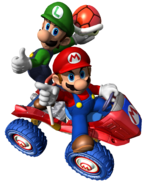
In the series of Mario Kart games, starting with Super Mario Kart, Mario has always been a playable character. In games where characters are divided into weight groups, Mario is always a middleweight character. Numerous tracks throughout the series have been called Mario Circuit, or something with the name "Mario" in it.
Mario appears in the Mario Kart series in the first installment: Super Mario Kart. Mario is average in all categories. When used by a computer, he sometimes uses star power, which gives him invincibility. Mario is used again for Mario Kart 64, where he is featured as a middleweight average-stats character. In Mario Kart: Super Circuit, Mario is once again used as middleweight characters with average speed and weight.
In Mario Kart: Double Dash!!, he is grouped with Luigi by default, and their special item is the Fireball. His kart is the Red Fire, which is an all-around average kart.
Mario once again returns as a character in Mario Kart DS. His karts are the B Dasher, the Standard MR, and the Shooting Star. After beating the game, Mario can race in any of the karts. Mario later returns as a character for Mario Kart Wii. Unlike the previous installment, in Mario Kart Wii, Mario can ride on any of the medium Karts and Bikes. Mario also provides a small boost to handling, weight, and acceleration on any vehicle he drives. Mario returns as a playable character in Mario Kart 7. Like in the previous titles, he is a medium class racer, and most of his stat boosts are around average levels. Mario is set to return in Mario Kart 8, appearing with the same stats in the previous titles.
In Mario Kart Arcade GP, he is an all-around type and shares his special character items with Luigi. His special items are a star, which gives Mario invincibility; a fireball, which can be shot forward or backward to damage a kart; the hammer, which can hit a rival, giving them damage; and the Chain Chomp, which provides damage to any kart it hits. Mario then appeared in Mario Kart Arcade GP 2, the sequel to the original. Mario, as Luigi, Pac-Man, and Waluigi, is an all-around racer. Mario reappears in Mario Kart Arcade GP DX as yet again a balanced middleweight character. His personal kart is the Lightning Champ. He also receives a Fire Mario alternate palette swap.
Yoshi's Safari
InYoshi's Safari, Mario and Yoshi are sent by Princess Peach to rescue Jewelry Land from Bowser's occupation. In this game, Mario uses a gun called the Super Scope (controlled by the player with said accessory for the Super Nintendo) to shoot enemies while riding on Yoshi's back. Mario fights the Koopalings and Bowser to free King Fret and Prince Pine of Jewelry Land.
Mario & Wario
In Mario & Wario, Mario is a passive character. Wario drops buckets or barrels or similar objects on his head, making him unable to see. The fairy Wanda has to guide Mario safely to Luigi through hazards and traps in each level. When arriving at the end of the level, Luigi will free Mario from the sight-blocking object. Mario is only one of the characters that have to be guided through levels by Wanda like this in the game. The other characters are Princess Peach and Yoshi. Mario walks at a medium speed, while Peach is slow and Yoshi is fast.
Hotel Mario
In Hotel Mario, Mario and Luigi travel to the Mushroom Kingdom after an invitation for a picnic by Princess Peach. Upon arriving, the two find out that Peach has been kidnapped by Bowser, who has made her a "permanent guest" in one of his seven Koopa Hotels. Mario and Luigi travel from one Koopaling's hotel to the next, with Peach being brought to a new hotel every time the brothers have searched through the last one. After destroying most of the Koopaling hotels, Mario fights Bowser in his own hotel and defeats him. He then receives a kiss from Princess Peach, then congratulates the player as 'The best ever'.
In the game, Mario has to close all doors in a hotel in order to proceed. Mario can stomp on enemies to defeat them, similar to the Super Mario series. He can also hide in open doors and take elevators to change his level.
Mario Tennis series
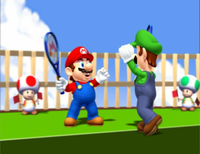
Mario is a playable character in all games of the Mario Tennis series, starting with Mario's Tennis. In Mario Tennis for the Nintendo 64, Mario Power Tennis for the Nintendo GameCube, Mario Tennis: Power Tour for the Game Boy Advance, and Mario Tennis Open for the Nintendo 3DS, Mario is an all-around character. In Mario Tennis for the Game Boy Color, Mario is an unlockable character, and can be unlocked by completing the Singles Mario Tour.
In Mario Power Tennis, Mario and Luigi are the only all-around characters. Unlike in other games, Mario and Luigi have subtle differences within each other. While they have nearly identical movement speed, Mario has more power while Luigi has slightly more reach and more control. Mario, when compared to other characters, has a slightly below-average reach and lunge because of his short stature. Mario is stronger than most non-power characters. All his other stats are average. Mario's Offensive Power Shot has his racket transform into a giant mallet, which enables him to hit the ball with high speed and force; opponents that return the ball may get blasted to the back of the court. Mario's Defensive Power Shot is a simple spin that allows him to reach lobs and faraway balls quickly, but it is one of the few Defensive Power Shots that fail when the ball is too far away. Mario's taunt is him waving and saying "Come on!".
Mario has appeared occasionally in several trophy-earning cutscenes in Mario Power Tennis. While Mario has appeared more than most characters in these cutscenes, Luigi appears in most trophy-earning cutscenes.
In Mario Tennis Open, Mario shares nearly identical stats from Mario Power Tennis.
Yoshi series
- Main article: Baby Mario
Super Mario World 2: Yoshi's Island
Super Mario World 2: Yoshi's Island tells the story of Mario shortly after his birth. At the beginning of the game, the Stork is delivering newborn Baby Mario and Baby Luigi to their parents, but Kamek, predicting that the brothers will cause problems for Bowser in the future, attempts to capture the stork and babies, but captures only Luigi and the stork. Mario, despite being safe from Kamek, starts to fall, eventually landing on a nearby island, on the back of Yoshi. Yoshi then brings Baby Mario back to his village, where they decide to help Baby Mario in saving his brother.
During the game, Baby Mario rides on Yoshi's back. When Yoshi is hit, Baby Mario falls off and is trapped into a bubble. If the Yoshi does not catch the bubble in a short period of time, Baby Mario is kidnapped by Toadies. In that case, the level has to be restarted. aby Mario can also run when Yoshi collects a Super Star, which transforms Baby Mario into Super Baby Mario for a short time.
At the end of the game, after Kamek and Baby Bowser's defeat and Baby Luigi's rescue, Baby Mario and Baby Luigi are brought to their mother and father.
Yoshi Touch & Go
Yoshi Touch & Go, unlike other Yoshi games, has no story. Where, when, and how the events took place is unconfirmed.
Each level in this game begins with Baby Mario with balloons, falling. The player must guide him with clouds while destroying obstacles with bubbles. Soon, Baby Mario lands on a Yoshi's back, and Yoshi finishes the rest of the level.
Yoshi's Island DS
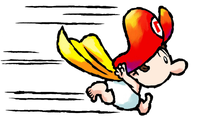
Kamek and his Toadies make a second attempt to ensure a safe future for the Koopa Troop in Yoshi's Island DS. They kidnap countless babies, searching for all of the Star Children. Mario and Luigi are taken from their home in the night as their parents cry out for them, unable to stop the kidnapping. However, the Stork notices Kamek and his Toadies taking away several babies. He attacks the Toady holding Baby Mario. The Toady panics and drops Baby Mario, who fell again towards Yoshi's Island. Yoshi and his friends again find Baby Mario and sought to defeat the Koopa Troop again. In the process, they learn to use the abilities Baby Mario grants to the Yoshi he rides on. They find Baby Peach, Baby Donkey Kong, Baby Wario, and Baby Bowser along the way, all whom work with the Yoshis to defeat the Koopa Troop. As they progress, Bowser travels from the future to assist his Koopa Troop of the past. The Yoshis are able to defeat him with the help of the babies. Baby Mario is returned to his parents alongside his brother and the family is reunited.
Mario Clash
Mario shoots at Koopas and various other enemies in Mario Clash, a game for the Virtual Boy. Mario has to knock enemies away with Koopa Shells at the side. The game's gameplay is similar to the style of Mario Bros., but Luigi is absent.
Super Mario RPG: Legend of the Seven Stars
Mario appears as the main protagonist in Super Mario RPG: Legend of the Seven Stars. Mario first arrives to confront Bowser who has again captured Princess Peach (which by now is a recurring event). Mario battles Bowser atop a Kinklink and rescues Peach. Then a huge sword, Exor, strikes the castle from atop and knocks them all to various spots in the Mushroom Kingdom. Mario falls through the Pipe on top of his house and lands on his bed.
Mario discovers that the Star Pieces that grants dreams are stolen by a group called the Smithy Gang runned by Smithy. They have not only stolen the Star Shards, but have also caused trouble to the Mushroom Kingdom. On this adventure, Mario recruits Mallow, Geno, Princess Peach, and even Bowser. They travel through much of the Mushroom Kingdom finding Star Shards, which are protected by the Smithy Gang's strongest members. After all Star Shards are collected, Mario fights Smithy. Mario reaches it through Bowser's Keep, which is inaccessible when Exor destroyed the bridge. With the help of Mallow's parents, King and Queen Nimbus, Mario has passage through a special cloud bus. When they finally arrived, Mario defeats Exor and goes to Smithy's dimension via Exor's mouth.
Mario's journey is not over since Smithy has even more minions at his disposal. After many battles, Mario faces and defeats Smithy, saving the Mushroom Kingdom.
Mario Party series
Mario is one of the playable characters in Mario Party series. He is always represented by his trademark red color. The minigames test Mario's luck, skill, and endurance and reward him with coins (or Mini Stars, in Mario Party 9 and in Star-Crossed Skyway in Mario Party: Island Tour). In the first three Mario Party games, Mario aims to become the superstar. Though Mario has few distinguishable abilities from the other Mario Party characters, the most notable difference is Mario's ability to use the Fireball Orb in Mario Party 7. Whenever Mario uses an Orb on a space, the space has Mario's "M" insignia. As revealed in the official artwork of Mario Party 4, Mario's item of choice is the Mega Mushroom. Mario's default Duel Mode partner is the defensive Koopa Troopa in Mario Party 3, and the booklet says that his favorite item is the Golden Mushroom. He also challenges the player for the Courage Star Stamp if he is not used.
Super Smash Bros. series
- Main articles: SmashWiki:Mario (SSB), SmashWiki:Mario (SSBM), SmashWiki:Mario (SSBB), SmashWiki:Mario (SSB4)
Mario has been playable in every Super Smash Bros. game to date. Mario has retained his balanced abilities even when fighting characters from other series. He brought with him many items, stages, and characters to compete in the tournament. Mario's alter-egos Dr. Mario and Metal Mario followed as well. Mario is usually portrayed as a "main" character alongside Link, Kirby, and Pikachu. He does not need to be unlocked in any Super Smash Bros. and is always playable at the start. Mario's skill is reflected by the player, as mentioned by the Adventure mode Mario trophy.
Solid Snake Codec Conversation
- Colonel: Snake, you know who that is?
- Snake: You're kidding, right? It's Mario.
- Colonel: Mario made his first appearance in 1981, and since then, he's become a worldwide phenomenon. There's probably not a single person who doesn't know Mario. He's that famous.
- Snake: Good thing I survived long enough to meet him on the field of battle, huh.
- Colonel: This is a once-in-a-lifetime chance, Snake. Now get out there and show him what you're made of. No regrets.
- Snake: Got it.
Role in the Subspace Emissary
In the beginning, a trophy of Mario and Kirby are thrown into an arena. The two come to life and fight. The player chooses the one to play with. If Mario is chosen, the opponent will be Kirby. After the battle between the two, Mario resurrects Kirby. This scenario happens the other way around if the player chooses Kirby instead. The Subspace Army then ambushes the two. Peach and Zelda come to help and they are all confronted by the Ancient Minister. After seeing the two R.O.B.s setting up a Subspace Bomb, Mario runs to try and stop it, only to be blasted away by Petey Piranha. Afterwards, he meets Pit after the latter has descended from Skyworld. They team up and reach land and give chase to the Ancient Minister, but they lose him.
Eventually, Mario sees Peach's trophy form apparently dissolving. Thinking Link and Yoshi have done this, Mario and Pit attack them, only to be defeated and stolen by King Dedede. Kirby, however, saves them both, and Pit shoots an arrow at the Cargo that Dedede was driving, blowing its engine out. Keep note that this only happens if Peach was rescued from Petey Piranha.
If Zelda is rescued, Mario and Pit end up facing a False Zelda, with Pit destroying her Dark Cannon that she was about to fire at Link and Yoshi. Link sees the Zelda trophy dissolve, and he and Yoshi attack Mario and Pit. Mario and Pit defeat them, but Mario sees the Peach trophy in the Cargo before Dedede takes Yoshi and Link. When Kirby saves them, Link is the one that blows out the engine.
Regardless, Mario and his team chase Dedede through a cave and into his castle, only to find his throne room a mess and himself and the trophies he had nowhere to be found. They go through a secret passage and see Bowser trying to get away. Mario attacks, only to find that he has the princess not rescued from Petey Piranha. Pit fires an arrow, but Bowser dodges, and the badge that the princess was wearing falls. Bowser gets away, and Kirby eats the badge.
Mario and his team encounter the Ancient Minister again later and chase him through the Wilds, but the R.O.B.s stop them and detonate the Subspace Bomb that the Ancient Minister was carrying. Mario and his team escape and end up fighting the Subspace Army at the Canyon where they meet the Ice Climbers, Marth, Lucas, the Pokémon Trainer, and Ike.
Eventually, the rest of the heroes join them and they head off into Subspace itself, taking down a Subspace Gunship along the way. In Subspace, they discover that Tabuu was behind the Subspace Army after all. Tabuu fires his Off Waves at them, turning them all into trophies. Mario was then rescued by King Dedede and his team consisting of Luigi and Ness; it turns out that Dedede knew of Tabuu and designed the badges to revive fighters from their trophy forms after a certain amount of time. Luigi and Ness were wearing the badges, and the one Kirby had eaten revived him as well. Everyone else was recovered by either Dedede's team or Kirby, with Bowser, Ganondorf, and Wario, who all had been working with the Subspace Army, joining them after learning about what Tabuu had done. Everyone went to confront Tabuu in the center of the Great Maze. Tabuu attempts to use his Off Waves again, but Sonic the Hedgehog suddenly appears and attacks Tabuu's wings, weakening the Off Waves considerably. Although the Off Waves were still powerful enough to score an instant knock out on someone, Mario and the others were able to defeat Tabuu, restoring most of the world back to normal.
Special Moves
Fireball
- Main article: SmashWiki:Fireball
Mario shoots red fireballs out of his palm. It is his normal B move, and it is used by the Mario and Luigi in all three games. Mario's Fireballs are affected by gravity (meaning they bounce against the ground), while Luigi's shoot straight no matter what, unless it ricochets off something in front of Luigi. Kirby can also use the Fireball move once he has sucked up Mario.
The move originates from the Super Mario Bros. games, whereas if Mario or Luigi grab a Fire Flower, they gain the ability to throw fireballs from their hands.
Cape
- Main article: SmashWiki:Cape
Mario uses Cape as an attack in each installment of the series (except for Super Smash Bros.). It is his Side + B move. While this attack is not particularly powerful, it is useful in that it can reverse the direction of certain projectile attacks. It can also make the foe spin around, and face the other direction. Also note that when Mario uses his cape it is not actually tied around his neck but held in his hand and swung.
The move originated from Super Mario World, when Mario grabs a Cape Feather, he will get a cape and can attack enemies just by swinging it.
Super Jump Punch
- Main article: SmashWiki:Super Jump Punch
The Super Jump Punch is a jumping move Mario, Luigi, and Dr. Mario can perform in the Super Smash Bros. series. It is executed by pressing B while holding the control stick upwards at the same time. When Mario performs the attack, coins fly out of the enemy, and the foe receives about 10% damage. Mario's Super Jump Punch has not changed at all throughout his appearances.
This move originated from Super Mario Bros., where if Mario jumps under certain blocks, coins will appear from the blocks. Plus, Mario, when using the move, would always be in the pose when he jumps in Super Mario Bros.
Mario Tornado
- Main article: SmashWiki:Mario Tornado
Mario Tornado is a special move that Mario can use as an aerial attack. After pressing B and tilting the control stick in the down position, Mario would spin around, suck the foe in, spin them silly, and then spit them out, damaging opponents, in a similar fashion to Luigi's Luigi Cyclone. The move is powerful, but is best used when surrounded by opponents. Mario Tornado, unlike Luigi Cyclone, cannot move very far. By repeatedly tapping the B Button, Mario will also move vertically while using the attack.
The Mario Tornado is replaced as his down special move by F.L.U.D.D. in Super Smash Bros. Brawl. Mario Tornado is still one of his normal attacks, executed by pressing Down A in mid-air. In both games, Mario can use the attack in mid-air. As Mario Tornado is in his down aerial attack, he can no longer perform the rising tornado technique, making his recovery worse.
It is possible that this move originated from Super Mario World, where it's called the Spin Jump, and/or Super Mario Land 2 where Super/Fire Mario can Spin Jump by jumping while ducking.
F.L.U.D.D.
- Main article: SmashWiki:F.L.U.D.D.
F.L.U.D.D. is a special move that Mario can use in Super Smash Bros. Brawl and Super Smash Bros. for Nintendo 3DS / Wii U. When Mario uses the move, he will put F.L.U.D.D. on his back and douse his enemies with water.
The attack will have no effect on the opponents' damage percentages whatsoever, however, it can still have a lot of benefit to Mario, as the water can blast foes great distances, possibly resulting in a KO. F.L.U.D.D. can also be charged before use, resulting in a more powerful stream of water. It is best used at enemies near the edges of the battle.
This move originated in Super Mario Sunshine, where the F.L.U.D.D. is a key element in the game. Using F.L.U.D.D., Mario can spray water at enemies, or clean up a part of a level. However, unlike in Sunshine, F.L.U.D.D. has various nozzles that can be used for various purposes, whereas in Brawl, F.L.U.D.D. can only use the spray nozzle.
Mario Finale
- Main article: SmashWiki:Mario Finale
The Mario Finale is Mario's Final Smash in Super Smash Bros. Brawl and is also the first Final Smash ever shown. As with any Final Smash, Mario must first collect a Smash Ball. Mario unleashes a giant wave of flames, which expands vertically before him. This bursts across the stage in front of him devastating any opponents in front of him by causing damage and pushing them off the screen along with the wave. It's not best to use it on the sides of a stage. Otherwise, the attack would not deal so much damage, even though it prevents opponents from getting behind Mario. This move was the first Final Smash shown in the 2006 E3 trailer. The move is an original one, not based on any specific power in the Mario series other than the traditional Fire Mario.
Paper Mario series
Paper Mario
Mario once again is invited to a party in Princess Peach's Castle in Paper Mario. Bowser interrupts, uprooting the castle and lifting it into the air. He and Kammy Koopa use the power of the Star Rod and defeat Mario. Bowser then tosses Mario out the castle. Mario lands in a small forest located on the outskirts of Goomba Village. Mario befriends Goombario, his first partner, and heads to Toad Town via Goomba Road.
Mario hears a Star Spirit called Eldstar asking for his help. The Star Spirit requests that he speak to him on Shooting Star Summit, in which he has more strength to speak better. Once there, Mario meets many other Star Spirits asking for his help. He learns that Bowser had imprisoned them in special cards and has given them to his strongest minions. Mario then sets out on a quest in search of the Star Spirits. Mario makes many new friends and partners, eventually collecting all seven Star Spirits. Mario returns to Shooting Star Summit where he gains access to Star Way. Mario acquires a new ability called Star Beam and is transported to Bowser's Castle from the Star Shrine. While Mario and his team are at Bowser's Castle, they save the many captives and fight Bowser at the top of the castle.
Bowser breaks the bridge Mario came from, ensuring that Mario cannot escape, and uses his Star Rod to fight. Mario, knowing the Star Rod's counter this time, uses Star Beam to weaken his power. The reluctant Bowser is unaffected by it and shakes the beam's power off. Watching the team's losing, Peach and Twink fight Kammy, who's responsible for creating the Power Platform that strengthens Bowser's Star Rod. They defeat Kammy and teach the Peach Beam while fully restoring Mario's party. Mario and company use the Peach Beam at Bowser the penetrate the Star Rod's shield, leaving him open to attack. Mario and his friends eventually defeat Bowser, and once again, save the Mushroom Kingdom. The castle returns to ground from where it came from and another party is held there later while the power of wishes is restored. After a parade led by Luigi, Mario takes Peach to his house,where they watch the fireworks.
Tattle
When Mario and his partner are battling in the dojo, Lee may transform into Goombario and use his tattle ability in battle.
- “It's Mario, silly! He's here to save Princess Peach, who was kidnapped by Bowser. Remember? He fights until the bitter end, no matter what enemies attack.”
- —Lee, Paper Mario
Paper Mario: The Thousand-Year Door
Peach asks Mario to come to a land called Rogueport in Paper Mario: The Thousand-Year Door. She has found a treasure map leading to powerful artifacts called Crystal Stars. By the time he arrives, the Secret Society of X-Nauts have kidnapped her. The X-Nauts need to use her as a vessel for the Shadow Queen so the leader of the X-Nauts, Sir Grodus, can use her power to aid him in world domination. Mario meet an intelligent Goomba called Professor Frankly. He tells Mario the history of Rogueport and reveals the secret of The Thousand-Year Door.
The Shadow Queen once takes control of Rogueport, trapping many of its citizens. To achieve this, she creates the Crystal Stars and uses them to give her great power. The Four Legendary Heroes use the power of the Crystal Stars against her and she is imprisoned in the Thousand Year Door for a millennium. Mario sets out to collect all seven Crystal Stars. Gaining many new partners and finding all Crystal Stars, Mario goes through the Thousand Year Door. There he finds Sir Grodus standing before the Shadow Queen's room. Mario defeats Sir Grodus, but is then ambushed by Bowser and Kammy Koopa. This gives Grodus time to escape with Peach to the Shadow Queen's room. When Mario arrives, Grodus has awakened the Shadow Queen herself, taking control of Peach's body. Mario has to fight her possessed form, and using the help of the Rogueport citizens' wishes, Mario prevails.
In the Glitz Pit, Mario and his partner's team is named "The Great Gonzales" (in Japanese: 『じごくかちまた しょけいにん』グレート・ゴンザレス) by Grubba.
Super Paper Mario
Mario and Luigi are once again called into action in Super Paper Mario. Mario and Luigi sit in their house one day when they hear the news that Princess Peach has been kidnapped. The Mario Bros. rush to Bowser's Castle, thinking he has the princess, an assumption to be proven wrong. Later, a new antagonist named Count Bleck shows up and kidnaps Luigi and Bowser. It is also revealed that Count Bleck has Princess Peach, too.
Mario is transported to Flipside, a town between dimensions. Mario later finds Bowser and Princess Peach who decide to join with Mario in his quest to stop Count Bleck. Mario must go through eight chapters to get eight Pure Hearts, which can counter the Chaos Heart. Mario also encounters new enemies such as O'Chunks, Dimentio, Brobot, Mimi, Nastasia and even his brother Luigi, now called Mr. L because Nastasia, an assistant of Count Bleck, has brainwashed him (however, he joined Mario once he is freed by Dimentio and sent to The Underwhere).
After collecting the eight Pure Hearts, Mario, Princess Peach, Bowser, Luigi and some Pixls face Count Bleck. After defeating Bleck, Dimentio, a former minion of Bleck, betrays Bleck and teleports him to Dimension D to deal with him later. Then Dimentio, the Chaos Heart and Luigi merge together to form Super Dimentio as the final boss. After Mario has defeated Super Dimentio, Count Bleck and Tippi get married to stop the Void. Mario is mentioned to be the first of the Heroes of Light.
Paper Mario: Sticker Star
In the latest installment of the Paper Mario series, Mario, along with Princess Peach and many Toads are celebrating Sticker Fest, a holiday where six Royal Stickers ride in on a comet, and it allows wishes to come true. Unfortunately, Bowser takes the comet for himself, releasing its Royal Stickers to him and his minions. Mario attempts to jump on him, but his efforts fail and Mario is knocked out. Shortly after waking up, he meets a sticker guardian named Kersti and with her help, saves some Toads hidden around the town and takes back the Royal Stickers. Mario then pursues Bowser by traveling through various worlds. Along the way, Mario must collect various stickers to aid him in defeating enemies and progress through levels.
After getting five of the six Royal Stickers, Mario is allowed to enter Bowser's castle. Bowser is defeated by Mario and he gets the last Royal Sticker, but Kersti is destroyed in the process. He releases Peach, who thanks Mario for his efforts and allows him to make a wish on the Sticker Star. He wishes for the return of Kersti, and the Sticker Fest is saved.
Luigi's Mansion
Mario plays his third role as a captive during the events of Luigi's Mansion. Mario visits a mansion that Luigi has mysteriously won. There, King Boo overpowers Mario with his many Boos and imprisons him within a portrait. King Boo is apparently mad at Mario for harassing his kind during his past adventures. Luigi comes later to discover why his brother did not come back. Luigi overcomes his cowardice and captures all Boos using his Poltergust 3000. After defeating King Boo, Luigi takes Mario's portrait and reverts him to his original form using Professor Elvin Gadd's Ghost Portrificationizer in reverse. Mario is left dizzy in the picture frame while Luigi laughs at him.
WarioWare series
Mario has made only minor appearances in the WarioWare series, being small cameos in some microgames. In WarioWare: Mega Microgame$, Mario is the "judge" in the microgame Ultra Machine. He and Bowser are also parodied in Classic Clash I, Classic Clash II, and Classic Clash III. In WarioWare: Twisted, Wario must greet him in the microgame Burying the Hatchet. In WarioWare: Touched!, he appears as a blackboard drawing in Jimmy T.'s microgame Chalk Full, and appeared in Wario-Man's microgames You Scratch Mine, alongside Wario and even Toad, and Where's Wario as well. Mario frequently appears in 9-Volt's classic microgames, like Super Mario Bros. and Super Mario Sunshine.
Mario & Luigi series
Mario & Luigi: Superstar Saga
After Mario's vacation, Mario ventures with his brother Luigi through foreign lands inMario & Luigi: Superstar Saga. An ambassador from the Beanbean Kingdom visits Princess Peach. However, the ambassador is actually Cackletta, and she steals Princess Peach's voice during the visit. Toad runs to Mario's Pad warning him about Princess Peach's voice dilemma. As soon as Mario comes out of his bathroom, he speeds to the castle, dragging Luigi behind him. There they meet Bowser, adding more to their troubles. Mario fights Bowser, but Peach speaks and interrupts their fight. As she speaks, explosives drop from her mouth and shake the castle. Bowser, outraged that another villain has stolen his spotlight, suggests that Mario and Luigi go to the Beanbean Kingdom with his Koopa Cruiser.
Cackletta's apprentice, Fawful causes the Koopa Cruiser to crash, causing Mario and Luigi to land on the Beanbean Borderlands. Mario and Luigi go to the Beanbean Castle after rescuing Prince Peasley from his transformation. After saving Queen Bean, they go to the Beanbean International Airport expecting Princess Peach. Clearing the Airport of a few Piranhas, the Toad Express lands on the runway. Mario and Luigi, surprised to see Princess Peach talking in her normal voice, ask how she has gotten her voice back. Princess Peach explains that the Peach that has her voice stolen is a decoy. After the Princess's visit, Princess Peach requests to go to Little Fungitown. During their short stay, she gets kidnapped. At Beanbean Castle, they hear from Bowletta (Cackletta's possessive body of Bowser) that the Beanstar has been scattered after the second battle with Popple and Rookie (Bowser as Popple's second-hand man). Mario and Luigi then travel to find the four scattered Beanstar Pieces. They managed to get all Beanstar Pieces. After that, they return to the castle, and Bowletta again sends a message to deliver the restored Beanstar to Joke's End, with Peach in return. At Joke's End, they saved Peach by disguising Luigi as her. Bowletta discovers this in her somehow-repaired Koopa Cruiser, but Luigi manages to escape safely.
Despite this, Bowletta also takes over Bowser's Castle and attacks the Beanbean Castle Town. Mario and Luigi ask Blanbladon to take them to the Bowser's Castle. After defeating many Koopalings and strong enemies, they reach the throne room. When they defeat Bowletta, she sucks them into her body where they have to fight Cackletta's Spirit. Mario and Luigi finally destroy Cackletta and her spirit. They escape from the castle (which is set to explode) in time, saving the Beanbean Kingdom.
Mario & Luigi: Partners in Time
Mario and his brother Luigi travel back in time in Mario & Luigi: Partners in Time. Mario and Luigi are at Princess Peach's Castle, watching Princess Peach go to the past using Professor E. Gadd's Time Machine powered by the Cobalt Star. A few minutes later, however, the Time Machine returns, but without Princess Peach. A large Junior Shrooboid attacks Mario and Luigi. They manage to beat it, allowing E. Gadd study it. Afterward, a Time Hole appears in the center court of the castle.
Mario and Luigi look at it in awe, when Toadsworth comes and accidentally knocks Luigi into the Time Hole. Mario enters it to save Luigi, and they travel back in time. They land on the starting road to Hollijolli Village, fighting more and more enemies. They see the village damaged and ruined by many Shroobs and Shroob UFOs. They then get assaulted and nearly defeated by a wave of Shroobs and Shroob UFOs. Meanwhile, Baby Mario and Baby Luigi rescues them by defeating the remaining Shroob foes.
Baby Bowser helps them escape from Baby Peach's incessant crying. They board his Koopa Cruiser and crash landed into Bowser's Castle as a result of the Shroob UFOs aerial attacks. Mario and Luigi look for their younger selves and head for Baby Bowser's room. There, a Time Hole is located and the four Mario Bros. head back to the Princess Peach's Castle of the present. Professor E. Gadd speaks to them and advises that they go find pieces of the Cobalt Star Shards.
Mario and the others notice the new Time Holes that appear around the castle. They meet Toadiko and Toadbert who tell them about the Shroobs and the Princess Shroob. They finally collect all five Cobalt Star Shards and break the barrier of the Shroob Castle (previously Princess Peach's Castle) and go for the Shroob Princess. The Mario Bros. defeat the Shroob Princess and even the Elder Princess Shroob and prevail. Professor E. Gadd discovers that the chemical makeup of the babies' tears can revert all of the Shroob's Shroobification. Thus, all the victims of the Shroobs are saved by the four Mario brothers.
Mario & Luigi: Bowser's Inside Story
Mario and Luigi appear again in Mario & Luigi: Bowser's Inside Story. A new disease, the Blorbs, which make Toads grow to a giant size, has affected the Mushroom Kindgom citizens from Fawful, who is selling Blorb Mushrooms. Mario and Luigi attend a meeting that is disrupted when Bowser barges in. Bowser then fights Mario. After defeated, Bowser receives a Vacuum Mushroom from Fawful. The mushroom makes Bowser inhale everything, including Mario, Luigi, Starlow, and the Princess.
Mario and Luigi are found inside Bowser, who is knocked out in Cavi Cape. The Bros. and Starlow help Bowser get his castle back from Fawful. Along the way, Bowser meets Broque and Broggy and gets the ability of the Vacuum block. Mario, Luigi, and Starlow aids Bowser in his trips, while they travel to various parts of his body. When Bowser finally reaches his castle and reclaims it, Bowser is grown fat from winning the fight against Midbus, a giant pig.
While Bowser is fat, Mario and Luigi find Peach in the Flab Zone, who is kidnapped in front of them by Alpha Kretin. After a long chase, Mario and Luigi trap and defeat Alpha and Beta Kretin, freeing the Princess. Peach, after the boss battle, tells them that Fawful probably wants the Dark Star, so he can control the Mushroom Kingdom. She also explains that Peach herself is necessary for this process. As they find an exit, Peach is taken out of Bowser's Body by Fawful and is once again kidnapped. Meanwhile, Midbus gives Bowser a treadmill to lose his extra pounds on.
Mario and Luigi travel until they find Bowser knocked out in a island of trash. After fighting Junker, they go back into Bowser, and wake him up from his back pain. After going through the castle all to finding the Dark Star awakening and Fawful becoming Dark Fawful, who is sent flying by Bowser. Dark Star enters Bowser, who copies his DNA, but is incomplete thanks to the Mario Bros., and combines with Dark Fawful to create Dark Bowser.
After Mario and Luigi defeat Dark Star Core and Bowser defeats Dark Bowser, Fawful explodes, destroying himself, and expelling everyone else from Bowser's body, freeing them. After realizing that the Mario's were inside Bowser, Bowser and Mario & Luigi fight, which ends the story. At the end, it is revealed that Mario and Luigi win yet again and Bowser is back at his ruined castle, recovering from the injuries he sustained in their fight.
Mario & Luigi: Dream Team
Mario reappears along with Luigi in the fourth installment of the Mario & Luigi series, Mario & Luigi: Dream Team, where he, his brother, Princess Peach, Toadsworth, and the Toads are invited to Pi'illo Island by Dr. Snoozemore through a message that was delivered by his Broggy. Mario & Luigi follow upon pursuing the two through the ruins, find Peach and Toadsworth surrounded by a group of Smoldergeist which flee when the Bros. arrive. Here they find a Pi'illo, which later turns out to be Prince Dreambert. This action causes the Smoldergeist to come back and attack the Bros., upon beating the group and leaving the ruins the Bros. come to a collection room. Here Luigi takes a nap on the pillow. After everyone gathers in the collection room, a Dream Portal opens a portal to a place called the Dream World. This allows Antasma, unknown by anyone, to pull Princess Peach into the world against her will. After Mario chases after Peach into Dreamy Pi'illo Castle, with the help of Dreamy Broque Monsieur, he comes across Dreamy Luigi, Luigi's dream representation, who assists Mario through his treks in the Dream World.
Mario vs. Donkey Kong series
The Mario vs. Donkey Kong series revisits the old Donkey Kong series, pitting Mario against a misbehaving Donkey Kong. The original Mario vs. Donkey Kong game, released in 2004, gave Mario the same moveset as 1994's Donkey Kong for the Game Boy and introduced the wind-up toys known as Mini Marios. The Mini Marios replaced Mario as the playable character in the later subsequent games, Mario vs. Donkey Kong 2: March of the Minis, Mario vs. Donkey Kong: Minis March Again!, Mario vs. Donkey Kong: Mini-Land Mayhem! and Mario and Donkey Kong: Minis on the Move, although Mario is still present in the storylines, as is Pauline.
Mario vs. Donkey Kong
Mario vs. Donkey Kong gives Mario the same moveset as in Donkey Kong for the Game Boy. Donkey Kong has stolen a lot of Mini Mario toys from the Mario Toy Company, and Mario chases after him to bring the toys back. Donkey Kong also kidnaps three Toads that Mario rescues. Mario vs. Donkey Kong is another game in which Mario speaks in full sentences.
All basic stages of the game are split into two rooms. In the first room, Mario has to find the key and take it to the looked door, just as in Donkey Kong. In the second room, Mario has to get to the Mini Mario, which is locked into a bubble, and free it. The seventh level of each world is a Mini Mario level, in which Mario has to guide six Mini Marios into the Toy Box. The Mini Marios follow Mario whereever he goes. For each Mini Mario brought into the Toy Box this way, Mario gets an additional hit point for the boss battle versus Donkey Kong, which always marks the eighth level of a world.
In the game's plus levels, which only consist of one room each, the Mini Marios hold a key, and follow Mario as soon as he approaches them. Mario has to safely guide it to the door in order to unlock it. There is no "Mini Mario level" in the plus worlds, and Mario enters the Donkey Kong boss fights with 6 hit points by default.
Mario vs. Donkey Kong 2: March of the Minis
Mario vs. Donkey Kong 2: March of the Minis starts with Mario and Pauline cutting the premier ribbon of the Super Mini Mario World Theme Park. After Pauline takes a Mini Mario toy from Mario, Donkey Kong kidnaps her. Mario chases after Donkey Kong to rescue Pauline, but his path is blocked. Instead of Mario, the playable characters in this game and all following installments of the Mario vs. Donkey Kong series are the Mini Marios. They clear the way for Mario to get to Pauline. Mario and Pauline feel sorry for Donkey Kong, and the three celebrate the opening of the theme park.
Mario vs. Donkey Kong: Minis March Again!
Mario vs. Donkey Kong: Minis March Again! begins once again with Mario and Pauline opening the Super Mini Mario World Theme Park, with numerous Toads and Donkey Kong waiting to get in. However, as Donkey Kong reaches the ticket counter, he sees that tickets are sold out, and, out of rage, kidnaps Pauline. Mario tries to save her, only to end up ripping off part of her dress, and DK escapes. Two Mini Marios then approach him, and Mario decides to use them to help save Pauline.
Eventually, Mario reaches the top of the building, where he finds Pauline in a room with one window. As they are about to hug, Donkey Kong flips the light switch off, grabs Pauline, and leaps out the window, Mario and the minis following him.
After much more toil, Mario once again enters the room, where he finds DK, Pauline, two Toads, one blue and one green, and two Mini Marios. Confused, Pauline reveals that the entire adventure was to test the Mini Mario product, and the group decides to celebrate.
Mario vs. Donkey Kong: Mini-Land Mayhem!
In Mario vs. Donkey Kong: Mini-Land Mayhem!, Mario and Pauline are once again opening a theme park, but this time, he is giving away Mini Pauline toys to the first 100 guests. Donkey Kong, wanting a Mini Pauline, charges through the line to get to the front, but finds out that he is visitor 101. When he learns from Mario that the toys are out of stock, he goes into yet another fit of rage, capturing Pauline. Mario once must again rely on his minis to help get Pauline back.
After much journeying, Mario defeats DK, and tries to hug Pauline, but Donkey Kong captures her again, leaving Mario to chase after him again.
Mario once again defeats Donkey Kong, after many more challenges. As Donkey is about to capture Pauline again, Mario offers him a Mini Pauline. Donkey Kong accepts this gift, and, happy again, the entire group decides to ride the ferris wheel.
Mario and Donkey Kong: Minis on the Move
The Mini-Marios again play a major role in Mario and Donkey Kong: Minis on the Move. Unlike the other Mario vs. Donkey Kong games, this game has little story.
Yakuman DS
Mario appears in Japanese-exclusive game of mah-jong in Yakuman DS as a playable character or rival. He is a default character as usual in the Mario spinoffs. As a rival, he has normal difficulty and relies on a balanced playstyle.
Dance Dance Revolution: Mario Mix
Mario dances to save the Mushroom Kingdom in Dance Dance Revolution: Mario Mix. Waluigi goes to Truffle Tower to gain Music Keys and grant him the power to "hypnotize the rhythm-less masses". However, after he opens the door, all but one key fly to various locations in the Mushroom Kingdom. One of the music Keys are found in the sea, another one in Mushroom Park, and another in Freeze Mountain. Toad, who sees this occur, rushes to tell Mario (or Luigi). If all keys are not returned, they can be exploited by anyone.
Mario responds by setting out to find all four Music Keys, along with Toad. Using his S.S. Brass to navigate, Mario challenges the key owners to dance-offs. Mario then faces Waluigi (and other enemies) to a dance-off and gets all four Music Keys back.
After getting the keys, Bowser stole them. Bowser goes to his castle and Mario follows him with the S.S. Brass. Mario performs the "Final Dance Off" with him and gets the Music Keys back. They then are all returned to the Truffle Tower.
Mario Baseball series
Mario is also playable in Mario Superstar Baseball and Mario Super Sluggers. Again, Mario is a balanced character, although he is a bit of a slow runner in the first game. Mario's special ball is the classic Fireball, which dazzles other players with smoky speed. Mario's abilities are very similar to Luigi's. Mario's default team is the Mario Sunshines in Mario Superstar Baseball which mostly consists of the non-playable characters from Super Mario Sunshine.
Mario's special abilities include Wall Jump, which can help Mario catch fly balls at the edge of the field, and an improved Sliding Catch.
In Mario Super Sluggers, Mario's team is called the Mario Fireballs, which consists of the Mario Bros., the Baby Mario Bros., Piantas, Nokis, a Monty Mole and a Blooper. Mario also had his batting and running skills improved, while his pitching and fielding remain the same. Mario's ability is Enlarge, which enables him to knock away third base and home base players and possibly the baseball if he succeeds a close play.
Super Princess Peach
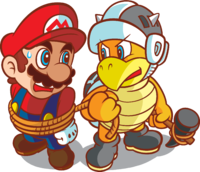
Mario is once again a Damsel-in-Distress during the events of Super Princess Peach. Bowser sends an army of Hammer Bros. (led by Army Hammer Bro.) and Goombas to invade Princess Peach's castle. Mario, Luigi, and the Toads, busy defending the castle, are subdued by the power of the Vibe Scepter and captured by a group of Hammer Brothers. Princess Peach is not in the castle at the time and so escaped the attack. Mario and the others are sent to Vibe Island, the source of the enemies' power. There they have no power to escape so Princess Peach, along with a magical umbrella named Perry given to her by Toadsworth, go there to rescue them. After defeating many of Bowser's minions and rescuing Luigi and a number of Toads, Princess Peach defeats Bowser using emotional powers called Vibes and rescues Mario. Princess Peach kisses him, and he gives her a bunch of flowers.
Mario Hoops 3-on-3
In Mario Hoops 3-on-3, Mario is a default character. His Special Shot was the Fire Shot, which involves Mario dribbling the ball around him in the shape of an M, and then either alley-oop or dunk a flaming red basketball into the hoop. To execute this move, the player must tap the touchscreen in the shape of the letter M. Mario is classified as a balanced character.
Mario Strikers series
In the Mario Strikers (or Mario Football in the PAL regions) series, Mario takes on yet another sport, soccer (also known as football). His stats are all-around in both games, Super Mario Strikers and Mario Strikers Charged. His Super Strike in Super Mario Strikers is the Fire Strike. His Super Ability in Mario Strikers Charged is Super Mario!. Unlike previous sports games, where Mario stayed in his usual traditional outfit, in the Mario Strikers series, he is seen wearing different gear, including different clothes and wearing cleats. In either game, Mario's team number is 1, and captain type is Balanced.
Mario & Sonic series
Mario also appears in Mario & Sonic at the Olympic Games, Mario & Sonic at the Olympic Winter Games, Mario & Sonic at the London 2012 Olympic Games, and Mario & Sonic at the Sochi 2014 Olympic Winter Games. In all four games in the series, Mario is classified as an "All Around" character. He participates in a variety of Olympic events, such as swimming, track & field, and archery. In the Adventure Tour of the DS version of Mario & Sonic at the Olympic Winter Games, he joins forces with Sonic the Hedgehog to save the Snow Spirits from Bowser and Dr. Eggman. Here, he finds fellow characters and completes their challenges so they can form a team to defeat Bowser and Eggman.
In Mario & Sonic at the London 2012 Games, specifically from the one for the Nintendo 3DS, Mario is a part of the "Heroes" group, which includes him, Luigi, Sonic, and Tails. He can participate in events only when it involves this particular group. In the story mode, a thick fog has engulfed London, which has prevented events from happening, a scheme of Bowser and Eggman. Mario and his group also encounter foggy clones of themselves that challenge them to certain events. After the clones are defeated, the Heroes find machines responsible for the fog and destroys each of them. Bowser and Eggman resort to the fog to make themselves invincible, but the Heroes eventually beat them.
Mario again reappears in Mario & Sonic at the Sochi 2014 Olympic Winter Games. Since there is no handheld version of the game, Mario does not participate in a specific story.
Throughout the games, Miis can don several costumes. Some resemble Mario's forms, such as Bee Mario, Propeller Mario, and Fire Mario.
Mario Sports Mix
Mario appears in Mario Sports Mix. He is an All-Rounder type character, and all of his stats are average. His stadium in the game is Mario Stadium. Most of his attacks involve spinning. In Basketball, he spins into his opponent if he is blocking his opponent for too long. In Hockey, his hits involve a two hit combo followed by a spin. In dodgeball, he rolls forward to avoid any incoming hit. In Volleyball, he spins when he spikes. In all sports, his special move is a fire blast that is so powerful that opponents have to resist the force while sliding backwards if they do not want Mario to score.
Luigi's Mansion: Dark Moon
While Mario reappears in Luigi's Mansion: Dark Moon, he plays a relatively minor role in the game. Prior to the final boss battle, Mario is found trapped as a sketch in a painting again. Mario is not directly referenced or seen until in Haunted Towers, where Luigi sees the Boos holding an upside-down portrait of his being trapped. There, only his feet are showing. Later, King Boo reveals that he trapped him and engages Luigi in battle. After King Boo is defeated, Luigi frees Mario with his Dark-Light Device, after which he, Mario, E. Gadd, several ghosts, and several Toads pose for a picture.
Other appearances
Mario has been featured as a titular character in educational games like Mario Teaches Typing, the Mario's Early Years games, as well as Mario Paint. Mario is also seen on the cover art of Alleyway, where he is seen controlling the paddle. The Mario's Picross series depicts Mario as an archeologist. He is also featured in the built-in Augmented Reality Games as a Character Card, a traceable image, and a stamp. Mario makes a cameo as a stamp for photos in the Game Boy Camera peripheral. It is seen also on the title screen dancing. His nose with his moustache also do make a cameo as a separate stamp.
Super Mario-Kun, an ongoing comic book series in Japan, has been running for more than 20 years.
Mario also appeared as the most expensive purchasable character in Nintendo Monopoly. Costing $400, he replaced the Boardwalk. On the ? Block and Coin Block (later Block) cards he replaced Mr. Monopoly. Mario has a neon sign that depicts him. Mario T-shirts, toys and alike have also been produced, and McDonalds released a chain of toys based on the popular Mario videogame Super Mario Bros. 3, as seen here.
Cultural impact
Mario is often said to be the most famous video game character in history. A Q Score survey made in the early nineties showed Mario was even more popular than Mickey Mouse[8], and he has the only wax statue of a video game character, which stands in the Hollywood Wax Museum.
The Mario series is the best-selling video game franchise in history; it is the flagship series of Nintendo, and Mario is the company's mascot, furthering his publicity even more. According to the Guinness World Records’ 2008 edition, Mario has appeared in a total of 116 separate games, which is more than any other video game character.[9]
General information
Physical description
Mario's distinctive look is due to technology restrictions in the mid-1980s. With a limited number of pixels and colors, the programmers could not animate Mario's movement without making his arms "disappear" if his shirt was a solid color, so Mario got overalls. They did not have the space to give him a mouth. As a result, Mario has a mustache. They could not animate hair. Due to this, they used a cap to bypass these problems. Mario's creator Shigeru Miyamoto has also stated when interviewed that Mario wears a cap because he finds it difficult to draw hair, the same reason Mario and Luigi have mustaches.
When Mario was first conceived, he looked more or less as he does today: a stocky man with a trademark hat, brown hair, black mustache and overalls who is 155 cm (5 ft, 1 in) tall[10]. He normally wears blue overalls on top of a red shirt, but such was not always the case. Originally, he wore red overalls on top of a blue shirt - almost exactly the opposite of what he wears now. The Famicom version of Mario Bros. was the first game to depict Mario with blue overalls and a red undershirt (Although on the boxart he was depicted entirely in blue); however, it was Super Mario Bros. 2 that standardized today's blue overalls-on-red shirt outfit. (Due to color limitations, the original Super Mario Bros. has neither in-game; Mario wears a brown shirt with red overalls). Mario's outfit rarely changes, though he is known to change it on occasion if the situation calls for it. For example, in Super Mario Sunshine, Mario wore short sleeves instead of his usual long sleeved shirt, and could even forgo this entirely in favor of a more tropical shirt design worn over his normal shirt, which he always wore with sunglasses. When Mario appeared in Super Smash Bros. Melee and Super Smash Bros. Brawl, his clothing was much more realistic than it was in Super Smash Bros.. In Super Smash Bros. for Nintendo 3DS / Wii U, Mario has brighter colors and less details to his overalls compared to his appearance in Super Smash Bros. Brawl.
Mario from his Super Mario 64 appearance is depicted with darker blue overalls and bigger eyes than in his current appearance based from the one in Luigi's Mansion. He has a slightly darker skin, and his ears are also rounder. His overall straps are longer as well, and his cap is less round. The shape of his face is also less defined, with less prominent cheeks.
Mario has brown hair (although the DiC cartoons sometimes depict it as black), with three swooped up bangs. There are two flips at the top and four at back of the head. Luigi, Wario, and Waluigi's hairstyle have very similar traits. Mario's mustache was shown to be black, but more recent artworks depict it to be very dark brown. Mario's mustache also has six bumps on the bottom. Like most other Nintendo characters, he has light blue eyes.
Clothing
Since he's a plumber, Mario is typically shown wearing his trademark outfit wherever he goes. He has a long-sleeved red shirt with a noticeable collar at the neck, and are tucked under a nice pair of white gloves with cuffs at the wrist and three plaits on each. Layered over the shirt is a pair of royal blue overalls with light yellow buttons, and stop at his ankles. On his feet is a pair of light brown work shoes that curve to just above his heel, with tan bottoms. In the Paper Mario series, these are known as the Boots.
Mario's trademark is his red hat with a fringe at the front and a small dent on the back. In the center at the front is a white circular plait with a red "M" in the middle. It is his trademark and most distinctive characteristic. It is really important for him because if he loses it he takes more damage. He has had the cap since he was born. In Super Mario Sunshine, if he lost the cap he would lose health due to the extreme heat.
In RPG games, Mario wears badges that give him new attacks or abilities.
Alternate Outfits
In Super Mario Strikers, Mario wears a red soccer jersey with black and dark gray-blue accents and his name on the sleeves, bermuda shorts that are half red and half dark grey-blue with white stripes and his "M" symbol on the left leg, and red and black wristbands. His jersey number is 1 decorated with a fire, Mario's associated element. His shoes has M streaks on the side, much as how his hat has the letter. Mario's gloves also have large plaits in the center. In the sequel, Mario Strikers Charged, since the sport has more physical contact, Mario is given red armor on his chest and his shoulders while he is given black sleeves . His gloves are also replaced with gauntlets. His shirt also has a bigger flame. His icon is an "M" on his cap, but the "M" is encased in fire.
In Super Mario Sunshine, Mario's outfit is basically the same, except his shirt has short sleeves that reach up to his elbows, and his overalls seemed tighter.
In the Super Smash Bros. series, his clothes seemed realistic, with his shirt having more wrinkles, as well as having denim overalls. The buttons on the straps are golden instead of light yellow.
Sometimes, Mario's clothes change color. Mario can use Badges to change his overalls in Mario & Luigi: Superstar Saga, Mario & Luigi: Partners in Time, Mario & Luigi: Bowser's Inside Story and Paper Mario: The Thousand-Year Door. The overalls turn red when he powers up into Fire Mario, and originally, the overalls were always red while the shirt was blue. He can also wear clothes that make him look like Luigi, Wario or Waluigi in Paper Mario: The Thousand-Year Door.
The Mario Strikers games are the exception when it comes to outfit changes in the games. Mario dons in his classic plumber attire in most other sports games.
Personality
Mario is known for being courageous and headstrong, and is also eager and cocky in certain occasions. He has an immutable sense of heroism, friendliness, and somewhat of a fiery personality. Despite his lengthy history, Mario is, in many ways, an undeveloped character, with many details of his accepted biography having been created through complex lore spawned from the imaginations of comic book artists, cartoon writers, and fans. In most media and some games, Mario is depicted as an Italian plumber from Brooklyn [11] who stands for what is right and has a love for Italian food. He is also bilingual, as he can speak both Italian and English. Mario has proven himself to be an excellent fighter, all-around sports player, and party lover in Mario spin-off titles.
Officially, Nintendo producers have stated that Mario's biography is kept simple in order to make the character versatile and reusable in many different games and situations. Mario is indeed one of the most underdeveloped characters in the Mario series, with characters such as Bowser and Princess Peach having more complex, consistent, and unique back stories. In fact, his brother Luigi has even gained more of a personality in recent games, while Mario has stayed "flat."
Over the course of his many games, Mario has rescued a number of people from captivity (including Pauline, Princess Peach, Princess Daisy, and Prince Pine) and has become regarded as a great hero in the Mushroom Kingdom. Mario is actually a famous personality across the world, and is a recognized celebrity inside and outside the Mushroom Kingdom. On the popular level, Mario is seen as the sole savior of the Mushroom Kingdom, while the contributions of others have been set aside. While not necessarily Mario's fault, Mario has remained in the limelight despite Luigi's (though less frequent) contributions. In addition, Mario has been shown on very some occasions, such as certain cutscenes in Mario Power Tennis, but often in Super Mario-Kun, to have an almost overbearing attitude towards his brother. However, this could also just be Mario's outgoing "big brother" personality interacting with Luigi's more introverted nature.
Additionally, Mario is much more impulsive and aggressive than his brother Luigi and is willing to enter dangerous situations all alone. Mario will often attempt to quickly solve a problem with his actions. Mallow even had to physically restrain Mario from brawling several times, such as before the battle with Bowyer, so that the heroes could figure out what exactly was happening to their world. While he will accept help and even partners during his adventures, at times he may also resent the implication that he needs the help in the first place. Despite this, he seems to enjoy their company. In the Super Mario-Kun, Mario is short-tempered, and he resorts to yelling at his friends for failing or making uncalled-for actions. In Super Mario-Kun, Mario is not above in certain vulgar actions, such as farting to taunt his opponents or urinating on Yoshi, and he also cross-dresses several times.
Despite these potential flaws, Mario is a kind-hearted and brave hero who often places the problems and needs of others before his own. This is shown in Paper Mario: The Thousand-Year Door when Doopliss steals his identity, and he is still willing to help Vivian with her problem. He is willing to risk his life to save the lives of millions from Bowser's destructive forces and any other villains he comes across.
Like many other protagonists of Nintendo games, Mario rarely speaks, his dialogue primarily limited to numerous grunts and yells. When he does speak, he speaks English with a heavy Italian accent. In Super Mario RPG: Legend of the Seven Stars, Mario is completely silent, communicating solely through pantomime. In the Paper Mario titles, he mainly communicates through simple nodding and hand gestures, and in the Mario & Luigi titles, he speaks in unintelligible gibberish that the other characters can understand perfectly. In Super Mario Sunshine, Mario is "heard" speaking in the opening scenes, but his dialogue is completely inaudible. In the Mario vs. Donkey Kong titles, Mario speaks fully, shouting sentences such as "Come back here, you big monkey!" He can be clearly heard shouting, "Welcome! Welcome, new galaxy!" in the ending of Super Mario Galaxy, as well as saying "Thank you so much for playing my game!" after the credits. Mario has also been shown full capable speech in Itadaki Street DS and Fortune Street. Despite Nintendo's emphasis on Mario as a silent protagonist, Mario is the most often heard speaking in full sentences, if occurrences outside the games (especially in special events in real life) are counted.
He has full speech capabilities in some sports games and outside games (including in real life) and also speaks regularly in the DiC cartoon trilogy, though he speaks perfect English with a Brooklyn accent in the latter. In a press conference, Mario is shown to be able to speak in full sentences.[12]. Also, people can communicate with Mario by asking various questions; there, too, Mario can fully speak. [13][14][15] In the games, other characters speak for him, mainly Lakitu and Toad.
Mario seems to have a small fixation with food. This is most notably seen in the DiC cartoon trilogy, which may also be the origin of this trait, where Mario is almost constantly hungry and fascinated with Italian food (mostly pizza and pasta), typically wanting to stop Bowser's latest scheme simply so he could eat and going to nearly any length to do so. In fact, in the The Super Mario Bros. Super Show! episode "Koopenstein", when Princess Peach asked him if he ever thought about anything besides food, Mario, with pure honesty, replied, "What else is there?" As in Super Mario 64 and its remake, the original reason Mario came to the castle is that Peach was baking him a cake. In the opening of Super Mario Sunshine, Mario is apparently daydreaming about seafood. In Fortune Street, he offers Yoshi to help by finding Yoshi's cookies, but before playfully saying, "just give me a second to brush these cookie crumbs out of my mustache!" Quite a few characters in other games also advised Mario to refrain from eating much.
Powers and abilities
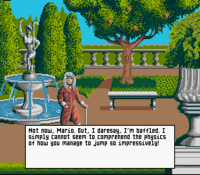
- Mario's main (trademark) ability is his Jump, which allows him to leap two stories high, while doing two flips and a twist. He is the second best jumper in the Mushroom Kingdom, only surpassed by Luigi. He is also capable of several variations, including the Long Jump, Back Flip, Spin Jump, and Wall Jump.
- Mario is always associated with the element of fire.
- Mario has very powerful feet, which have flattened innumerable enemies, toppled fortresses and even crushed spaceships.
- In Super Mario RPG: Legend of the Seven Stars, Mario is able to "transform" into other characters, which comes in handy, as he is a silent protagonist. This is not one of his attacks, however; he simply uses it to tell stories or explain situations to other characters.
- Mario can use a variety of martial arts attacks, including punching and kicking.
- Mario can perform many standard moves in the Mario series, such as the Ground Pound.
- Mario has been shown to possess superhuman strength. In Super Mario World, he is seen lifting a fortress out of the ground and then kicking it away. In Super Mario 64, he can carry and throw the very large King Bob-omb, despite the king being far larger than him. An even more impressive feat is during the battles with Bowser; Mario can grab him by the tail, spin him around and throw him. Mario spins Bowser around faster and farther with more spins. His strength is also shown in Super Mario Galaxy, where he can easily stun a Mega Goomba with a Star Spin despite its great size and his ability to knock Bowser around during battles with him. He can also lift Bob-ombs that were his size. In Bowser's Inside Story, he is able to, lift and throw a 3 ton, morbidly obese Luigi when using the Snack Basket move among other fantastic feats. In New Super Mario Bros. Wii, Mario is able to lift big barrels and frozen enemies as if it was nothing, even in tiny stature.
- Mario has a significant level of durability. He can withstand great impacts, such as falling from a height of several hundred stories (seen in Super Mario Galaxy) or being struck by opponents with superhuman strength, such as Donkey Kong or Bowser. Also, he can endure many things such as harsh environments. In the third Mario and Luigi game, he could withstand the freezing cold within Bowser's stomach or a dark energy blast from the Dark Star when Luigi had a difficult time shaking it off. Mario is very versatile and adapts amazingly fast to his surroundings, being able to go from scorching deserts to freezing snow peaks to the depths of outer-space. He can endure otherwise lethal hits (i.e. Burning, Electrocution, Freezing) several times before dying. An insane feat of durability is in Super Mario Galaxy, when in the end, Mario survives the supernova that wiped out the universe.
- Mario's first weapons were the Hammer in Donkey Kong and the Fireball in Super Mario Bros. Mario often uses the Hammer as a weapon in Mario RPGs. Mario can, in some games, such as Super Mario RPG: Legend of the Seven Stars), possess pyrokenesis, the ability to control fire without a Fire Flower power-up.
- Mario has thirteen power-ups that allow him to fly; the Super Leaf, the Tanooki Suit, the Cape Feather, the Wing Cap, the P-Wing, the P-Balloon, the Power Flower, the Bee Mushroom, the Boo Mushroom, the Red Star, the Propeller Mushroom, the Invincibility Leaf, and the Super Acorn. On The Super Mario Bros. Super Show!, Mario was able to fly even after powering up with a Fire Flower.
- In Super Mario Bros. 3, Mario had the ability to transform into a Hammer Bro with the ability to throw hammers at his enemies or a Frog which let him swim faster and jump higher.
- Mario has three other caps he can wear, the Metal Cap, Wing Cap and Vanish Cap, which turn him into Metal Mario, make him fly and make him invisible and intangible, respectively.
- Mario even has his own fighting style. Although he never really uses it in his games, except the Smash Bros. series, he does use the martial arts in a Super Mario Bros. 3 comic. In the comic, while fighting Lemmy Koopa, Mario says, "Good thing I know karate!" In the following panel, Mario jumps many times in a rapid motion, dodging all of Lemmy's attacks with ease. Mario also has a black belt in Plumb Fu.
- In Paper Mario, Mario can travel quickly on land with his Spin Dash, an ability he has from the beginning.
- In Paper Mario: The Thousand-Year Door, Mario becomes more paper-like and can become Flat Mario, Paper Tube Mario, Paper Airplane Mario, and Paper Boat Mario as a result of the "curses" cast upon him by the Black Chest Demons.
- In Super Paper Mario, Mario was given the ability to flip between dimensions.
- In Super Smash Bros. Brawl, Mario has a special attack called the Mario Finale, in which he unleashes a twin stream of fire from his hands, although he requires a Smash Ball in order to execute it.
- In the 2-D games, Mario is shown to run at a fast pace, even fast enough to run up walls.
- Mario is shown to have a very good grip, being able to hold on to poles and beanstalks without losing his grip. He also can hold objects such as POW Blocks (which are obviously heavy) for an infinite time.
Relationships
Family
Luigi is Mario's younger twin brother. Luigi often joins Mario on his adventures, and the two of them are normally paired together in sports titles and spin-offs. They have a strong brotherly bond and will stop at nothing to help each other when one is in trouble, as seen in in games such as Luigi's Mansion. While they love each other, in Paper Mario Luigi admits that he also feels jealousy towards his brother at times, and has also expressed that he is "tired of being Player 2", for despite being a hero in his own right, he is often overshadowed by Mario. While Mario jokes that "Luigi loves being my sidekick" in the Mario Sports Mix press conference, in Mario & Luigi: Bowser's Inside Story, he is quick to give Luigi proper credit for defeating the Shroobs in the previous game. At times, Mario does let sibling rivalry get the best of him, such as when he intentionally steps on Luigi's foot when the latter receives a trophy in Mario Power Tennis. In volume 36 of Super Mario-Kun, he also apparently ditches Luigi when Luigi is trapped in the Star Gate, much to Luigi's dismay, only to return quickly to see Luigi break into tears. Overall, however he acts as a good brother and role model for Luigi.
Mario and Luigi's parents cameoed at the end of Super Mario World 2: Yoshi's Island, although their faces were not seen and their names were not given, same as in their appearances in Family Album "The Early Years" and Super Mario Issun-bōshi. The Super Mario Bros. Super Show!, on the other hand, mentioned or featured Mama Mario in a number of episodes, depicting her as a strict woman who loves her boys very much. Their father did not appear in the show and very little is known about him, although the Super Mario Bros. film revealed that he came from a long line of plumbers and passed the family tools and the trade on to Mario. The Super Mario Bros. Super Show! and the comics also make references or depict various other relatives of Mario, including aunts, uncles and cousins, although none have appeared in any games.
Friends and love interests
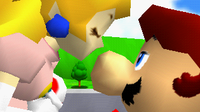
Mario saves Princess Peach quite often and she usually rewards him with a kiss him upon her rescue, and often bakes him cake as well. They care about each other very much, share good chemistry in sports games and have been good friends since childhood. In the German Club Nintendo comic "Warios Weihnachtsmärchen", it is even revealed that they spent their graduation ball in school together, and it is often said that the two have a romantic relationship in the present. The official European Mario website specifically lists Peach as Mario's girlfriend and in Mario Party 5, Peach and Mario are called "Cutest Couple". Mario Power Tennis even goes as far as showing Mario himself telling Peach of his love for her in Peach's victory scene, to which she smiles and blows him a kiss. The official guide of Yoshi's Island DS, the description for the level Baby Mario and Baby Peach: Dynamic Duo, states that before the "romantic entanglements" in their adult lives, they teamed up as babies to stop evil. While both Mario and Luigi deny a relationship when Luvbi asks if Peach was Mario's "lady friend", Luvbi also comments that the princess "looms large in his regard" and then wonders if Mario had a "one-sided crush". Other characters also know of the feelings between the two, with Rosalina calling Peach Mario's "Special One" in Super Mario Galaxy, Kersti saying she was the apple of his eye in Paper Mario: Sticker Star, and a Toad going so far as to tell Mario to take Peach on a date to Shooting Star Summit.
Peach has not been Mario's only romantic interest, however. In the original Donkey Kong, Pauline was Mario's first girlfriend and damsel-in-distress, but while he still has to occasionally rescue her in the Mario vs. Donkey Kong series, the two are simply friends now. In addition, when Mario saved Princess Daisy in her debut appearance in Super Mario Land, a heart appeared overhead, implying a romantic connection. This was never explored further, however, and while Mario Party 4 gave them the team name "Nice Couple", most games link Daisy with Luigi instead, with her and Mario simply being friends, not even sharing any player chemistry in the Mario Baseball series.
Mario's first friend was Yoshi, who, along with other Yoshis, saved him and Luigi from the Koopas when they were still babies. In the present day, Yoshi continues to help Mario against Bowser, usually serving as his steed, although he is capable of autonomously fighting alongside his human friend, as in Super Mario 64 DS. Another good friend of Mario's is Toad, who occasionally goes on adventures with him, as in Super Mario Bros. 2, various Mario cartoons and the Nintendo Comics System, where he was seen to be Mario's loyal and trusted sidekick. Toad trusts that Mario will always save the day and even when not fighting alongside him will be quick to offer advice and encouragement.
Foes and rivals
Bowser is Mario's arch nemesis and the two are locked in a neverending cycle of conflict. Bowser constantly tries to take over the Mushroom Kingdom and kidnap Peach, and each time he upsets the peace, Mario stops at nothing to defeat him and set things right. Occasionally the two team up to defeat greater evils, such as in Super Mario RPG: Legend of the Seven Stars, Mario & Luigi: Superstar Saga and Super Paper Mario, and while Bowser openly hates Mario and resents him for his close relationship with Peach, for his part, Mario has never truly shown hatred nor contempt against Bowser, and he is often more than happy to cheer up Bowser after he defeats him.
Bowser is not Mario's only foe, however, and in the original Donkey Kong, it was Cranky Kong (then known as "Donkey Kong") that Mario had to defeat. His grandson, the current Donkey Kong, and Mario are on much better terms and often participate in sports and spin-offs together, although they do maintain a friendly and somewhat competitive rivalry, and Mario has been forced to defeat Donkey Kong a couple times in the Mario vs. Donkey Kong series when the latter went overboard due to his passion for Mini Marios and Mario's ex-girlfriend Pauline, the same woman who had been abducted by Cranky Kong in the past.
Mario's main rival, however, is Wario. Various comics depict their antagonistic relationship starting in childhood, and it is a major theme in the Super Mario Kun manga. In Wario's first appearance, Super Mario Land 2: 6 Golden Coins, he stole Mario's castle, and in Mario Super Sluggers, he tried to destroy Mario, although for the most part, their rivalry is far more mild in nature, and the two even team up to defeat Bowser in Super Mario 64 DS. Nintendo Power has stated that Wario is Mario's cousin, but this is unconfirmed.
Occupations
Mario has had a number of jobs in the past. Some of these are:
| Job | Game/series |
|---|---|
| Carpenter | Donkey Kong |
| Plumber | Mario Bros. |
| Factory Worker | Mario's Cement Factory / Mario Bros. (Game & Watch) |
| Soldier | Mario's Bombs Away |
| Sportsperson | Tennis / Donkey Kong Hockey / Mario Golf series / Mike Tyson's Punch Out!! / Famicom Grand Prix series / Mario Kart series / Mario Tennis series / Paper Mario: The Thousand-Year Door / NBA Street V3 / Mario Baseball series / SSX on Tour / Mario Hoops 3-on-3 / Mario Strikers series / Mario & Sonic series / Mario Sports Mix |
| Demolition Worker | Wrecking Crew series |
| Physician | Dr. Mario |
| Baker | Yoshi's Cookie |
| Sensei (optional) | Super Mario RPG: Legend of the Seven Stars |
| President of Mario Toy Company | Mario vs. Donkey Kong series |
Aliases
Throughout his illustrious history, Mario has been referred to as various names besides "Mario". Here is a listing of his aliases from Mario games and The Super Mario Bros. Super Show!!.
| Name | Game or Episode Mario is referred to | Who/What refers to Mario |
|---|---|---|
| Basin Brain | "Jungle Fever", "20,000 Koopas Under the Sea" | Bowser |
| Big Brute | Super Mario 64 DS | Rabbit |
| Bro. | Paper Mario series, Super Mario Galaxy 2 | Luigi |
| Big Bro. | Various games | Luigi |
| Butch Mario | "Butch Mario & the Luigi Kid" | Episode title |
| Butterball | Super Paper Mario | Mr. L |
| Captain | Super Mario Galaxy 2 | Lubba |
| Captain 'Stache | Paper Mario: The Thousand-Year Door | Pa-Patch and Flavio |
| Captain Kidder | "Pirates of Koopa" | Himself |
| Clumsy Crush-a-lot | Paper Mario: The Thousand-Year Door | Zess T. |
| Crocodile Mario | "Crocodile Mario" | Episode title |
| Cutlet | Mario & Luigi: Dream Team | Big Massif, L'il Massif |
| Darling | Paper Mario: The Thousand-Year Door | Flurrie |
| Dear | Paper Mario: The Thousand-Year Door | Toodles |
| Dr. Mario | Paper Mario | Whale |
| Drain Brain | "Mario and the Red Baron Koopa", "Princess Toadstool for President" | Bowser |
| Drains-for-Brains | "Brooklyn Bound" | Bowser |
| Dumber Plumber | "The Trojan Koopa" | Bowser |
| Faucet Face | "King Mario of Cramalot", "Star Koopa", "Oh, Brother!" | Bowser, Luigi, Ludwig |
| Faucet Flop | "Crocodile Mario" | Bowser |
| Faucet Freak | "Jungle Fever" | Bowser |
| Gonzales | Paper Mario: The Thousand Year Door | Residents of the Glitz Pit |
| Handsome Mustache Man | Paper Mario: The Thousand Year Door | Ms. Mowz |
| Hero of Legend | Paper Mario: The Thousand Year Door | Black Chest Demon |
| Heroic Mustache Man | Paper Mario: The Thousand Year Door | Ms. Mowz |
| Horrible Rabbit Grabber | Super Mario 64 DS | Rabbit |
| Jumpman | Donkey Kong, Paper Mario: The Thousand Year Door | Donkey Kong, Audience member in the Glitz Pit |
| Lasagna Lovin' Loser | "King Mario of Cramalot" | Bowser |
| Luigi | Paper Mario: The Thousand-Year Door | Pennington (mistakenly) |
| Linguine Breath | Super Mario 64 | Wiggler |
| Little Lasagna Lover | "Mario Meets Koop-zilla" | Bowser |
| Little Mario | Donkey Kong Jr. | Game's flyer |
| Lunkhead | "Super Koopa" | Bowser |
| M | Mario Is Missing! | Luigi |
| Macaroni Mouth | "Star Koopa" | Bowser |
| Mario Master | "Oh, Brother!" | Ludwig |
| Mario-san | "Karate Koopa" | Misaki |
| Master Mario | Super Mario Sunshine, Mario & Luigi series, Paper Mario: Sticker Star | Toadsworth, A Toad |
| Maria | Super Paper Mario | O'Chunks |
| Mariotta | Super Mario RPG: Legend of the Seven Stars | Garro |
| Marty-o | Paper Mario: The Thousand-Year Door | Puni Elder |
| Mister Man | Paper Mario: The Thousand-Year Door | Goombella |
| Mr. Big Shot | Paper Mario | Red Goomba |
| Mr. Bigtime Gambler | "Rolling Down the River" | Luigi |
| Mr. Cutie | Paper Mario: The Thousand Year Door | Ms. Mowz |
| Mr. Jumpsallthetime | Super Paper Mario | Mr. L |
| Mr. Mustache | Paper Mario: The Thousand-Year Door | Beldam |
| Mr. Squishy | Paper Mario: The Thousand-Year Door | Zess T. |
| Murphy | Paper Mario: The Thousand-Year Door | Kroop |
| Muttonhead | "Pirates of Koopa" | Bowser |
| New Bee | Super Mario Galaxy | Queen Bee |
| Nozzle Nose | "The Mark of Zero" | Bowser |
| Old Man; Old 'stache guy | Super Mario Galaxy | Penguin |
| Pain-in-the-Drain Plumber | "The Ten Koopmandments", "7 Continents for 7 Koopas" | Bowser |
| Parmesan Plumber | "Mario Meets Koop-zilla" | Bowser |
| Pepperoni Plumber | "King Mario of Cramalot" | Bowser |
| Pesky Plumber | Various episodes | Bowser |
| Pinhead Plumber | "The Bird! The Bird!" | Bowser |
| Pipesqueak | "Oh, Brother!" | Bowser |
| Plumb Bum | "Mario of the Deep" | Bowser |
| Plumb Dumb | "King Scoopa Koopa" | Bowser |
| Plumb Scum | "The Unzappables", "The Ten Koopmandments" | Bowser |
| Provolone Bonehead | "The Provolone Ranger" | Bowser |
| Puny Plumber | "Karate Koopa" | Bowser |
| Red-Cap | Luigi's Mansion | One of the possessed portraits in the Parlor |
| Red man of mustache | Mario & Luigi: Partners in Time | The Star Gate |
| Robo-Router | "Robo Koopa" | Bowser |
| Royal Mario | "King Mario of Cramalot" | Mervin |
| Scum Scrubber | "The Bird! The Bird!" | Bowser |
| Sherlock Mario | "The Adventures of Sherlock Mario" | Episode title |
| Shortie | Super Mario RPG: Legend of the Seven Stars | Bowser |
| Shy Guy | Paper Mario | A Toad in Toad Town during Chapter 4 |
| Sir Stomp-on-Stuff | Paper Mario: The Thousand-Year Door | Zess T. |
| Slick | Paper Mario: The Thousand-Year Door | Doopliss |
| Stache | Mario & Luigi: Superstar Saga, Super Paper Mario | Various characters |
| 'Stache Man | Super Mario Galaxy 2 | Bob-omb Buddies |
| Stompy | Paper Mario: The Thousand-Year Door | Zess T. |
| Stupid Mario Bros. | "Crimes R Us" | Kootie Pie Koopa (Referring to both Mario and Luigi) |
| Super Coward Bros. | Mario & Luigi: Superstar Saga | Bowser |
| Super Stupid Bros. | Super Paper Mario | Bowser |
| Sweetie | Super Mario Galaxy 2 | Gearmo |
| Thanta Clauthe | Mario & Luigi: Superstar Saga | Hermie III |
| The Great Gonzales | Paper Mario: The Thousand-Year Door | Grubba, Yoshi, and other various characters. |
| The Human Blur | Super Mario 64 | Koopa the Quick |
| The Human Rocket | Super Mario 64 DS | Koopa the Quick |
| The Proverbial Mustache | Paper Mario: The Thousand-Year Door | Don Pianta |
| The Provolone Ranger | "The Provolone Ranger" | Episode title |
| Two-bit Tortellini Taster | "Mario Meets Koop-zilla" | Bowser |
| Whiskers | Mario & Luigi: Partners in Time | Kylie Koopa |
| Wretched Fool | Paper Mario: The Thousand-Year Door | Shadow Queen (Referring to both Mario and his partners) |
| Yeti-lip | Super Paper Mario | Fracktail |
List of game appearances
This is a list of game appearances for Mario. Minor appearances, including cameos, are not counted.
Official profiles and statistics
- Main article: List of Mario profiles and statistics
Super Smash Bros. series
Super Smash Bros.
- Instruction Booklet Bio: "The internationally-famous, mustachioed super-star. Mario's jumping action is the key to his success."
Stage: Peach's Castle - Game Bio: Although best known as the mustachioed plumber who battles the Turtle Tribe with his distinct jumping action, this internationally-famous hero has also acted as a referee, a driver, and even a doctor! He's been linked to Princess Peach of Mushroom Kingdom for years, but to this day their true relationship remains a mystery.
Super Smash Bros. Melee
Instruction booklet
"A well-rounded hero who boasts a balance between offense and defence."
Portrayals
Mario has been voiced by the following people:
- Tōru Furuya - Super Mario Bros.: Peach-hime Kyushutsu Dai Sakusen!, Amada Anime Series: Super Mario Bros., Satellaview games.
- Lou Albano - The Super Mario Bros. Super Show!
- Walker Boone - The Adventures of Super Mario Bros. 3, Super Mario World
- Ronald B. Ruben - Mario Teaches Typing
- Takeshi Aono - Mario Paint commercial
- Marc Graue - Hotel Mario
- Charles Martinet - Mario's Game Gallery - present
- Gorō Inagaki - 2003 "Hot Mario" commercial
- Takashi Okamura - 2005-2006 "Hot Mario Bros." commercials
Gallery
- EveryoneDKNES.png
- MarioSMB2..png
- PM Mario.gif
- SMS-Mario Jump FLUDD.png
Quotes
- Main article: List of quotes by Mario
Games
- "Lets-a-play!" - Mario Tennis: Power Tour/New Super Mario Bros. Wii/Super Mario 3D Land
- "It's-a-me, Mario!" - Super Mario 64
- "Let's-a-go!" - Various games
- "Thank you so much for-a playing-a my game!" - Super Mario 64/Super Mario 64 DS/Super Mario Galaxy/Super Mario Galaxy 2
- "It's-a Mario Time!" - Various games
- "Here I go!" - New Super Mario Bros.
- "Mama-mia!" - Various games
Mario comics
- Main article: List of quotes in Mario Comics#Mario
Mario cartoons
- The Super Mario Bros. Super Show!
- Main article: List of quotes in The Super Mario Bros. Super Show!#Mario
- The Adventures of Super Mario Bros. 3
- Main article: List of quotes in The Adventures of Super Mario Bros. 3#Mario
- Super Mario World
- Main article: List of quotes in the Super Mario World television series#Mario
Names in other languages
Trivia
- When Mario optionally returns to the Glitz Pit to fight Rawk Hawk a second time, someone in the crowd yells, "Jumpman! Wait. Who?" Mario's name in Donkey Kong was Jumpman.
- Mario's full name is given as "Mario Mario" in the Super Mario Bros. movie. In a few isolated cases, this has leaked into other media - for instance, the Prima guide book for Mario Party 2 lists his name as Mario Mario in a note section. Also, when people asked Mario (voiced by Charles Martinet) what his last name was, he had responded with this: "My name's-a Mario Mario. Of course, my brother's name, a-Luigi Mario. And of course, my mama's-a Mama Mia Mario; my papa Papa Pio Mario. Of course, my grandmama Grandmama Mia Mario and my greatpapa et cetera, et cetera. Yeah, first name Mario, last name Mario. Yahoo!".[16] However, Nintendo of America has stated that "there are no last names."[17] This was also recently confirmed by current Nintendo President Satoru Iwata.[18]
- However, in the games, Shigeru Miyamoto has confirmed that both Mario & Luigi's last names are anonymous and doesn't relate to their last names in the movie as seen above.
- Despite a life-size poster measuring at 5'1", crossover artwork shows Sonic the Hedgehog (who stands at 3'3") to be at least two or three inches taller.
- According to his trophy description in the Japanese version of Super Smash Bros. Melee, Mario is stated to be "26 years old".[19]
References
- ^ http://us.wii.com/iwata_asks/mario25th/vol2_page4.jsp
- ^ http://games.ign.com/articles/833/833615p1.html
- ^ Scullion, Chris. (April 30, 2010). "10 Amazing Mario Facts". The Official Nintendo Magazine It is stated that Jumpman was renamed in honour of the warehouse landlord, Mario Segale, following an altercation between him and a Nintendo employee. (Retrieved December 23, 2011)
- ^ Pryne, Eric. (March 27, 2010). "Powerful Segale family has massive vision for Tukwila expanse". The Seattle Times. Excerpt: ""You might say I'm still waiting for my royalty checks," Segale told The Seattle Times in 1993. He didn't confirm widely circulated stories that "Super Mario" got his name after Segale stormed into Nintendo's office, angrily demanding overdue rent. But many business associates say those tales fit the Mario they know — a hard-driving businessman who can be warm and generous, but also can display a temper when he doesn't get what he wants.. (Retrieved December 19, 2011)
- ^ Edwards, Benj. (April 25, 2010). "The True Face of Mario". Technologizer. It is reported that it was Nintendo of America president Minoru Arakawa who noticed the similarities between their Donkey Kong character and Mario Segale. (Retrieved December 19, 2011)
- ^ Thiel, Art. (2003). Out of Left Field: How the Mariners Made Baseball Fly in Seattle. Sasquatch Books. pp. 44–45. Another recount of the Mario Segale encounter that led Minoru Arakawa and the other NOA employees to name their character "Mario". (Online book accessed December 19, 2011)
- ^ An alternate box art of Mario Is Missing! sported the "Mario Discovery Series" symbol.
- ^ http://www.guardian.co.uk/technology/gamesblog/2010/sep/13/games-gameculture
- ^ http://videogames.yahoo.com/events/plugged-in/groundbreaking-hit-super-mario-bros-celebrates-25th-birthday/1410955
- ^ http://kotaku.com/186665/five-foot-tall-mario-statue-for-sale The Japanese poster says "Life-size Mario!!"
- ^ http://uk.youtube.com/watch?v=ZnSi7ihAhsQ Retrieved 28th July 2007
- ^ http://www.youtube.com/watch?v=eQVjYNE2Kew
- ^ http://www.youtube.com/watch?v=9ihWsOcbS_E
- ^ http://www.youtube.com/watch?v=atM5ZjqVVE4
- ^ http://www.youtube.com/watch?v=AAjhjLuWbC8
- ^ http://www.youtube.com/watch?v=AAjhjLuWbC8
- ^ http://www.youtube.com/watch?v=aMyYRy5SgIM#t=02m00s
- ^ http://kotaku.com/5935721/super-marios-boss-doesnt-want-to-overdo-it-with-mr-video-game-and-wont-deceive-you-with-dlc
- ^ [1]
- Humans
- Plumbers
- Heroes
- Cloned
- Hostages
- Kings
- Koopa Troop
- Magicians
- Merchants and Salespeople
- Pirates
- Police
- Protectors of the Mushroom Kingdom
- Royalty
- Shapeshifters
- Shopkeepers
- Siblings
- Villains
- Captains
- Allies
- Bosses
- Forms
- Unlockables
- Characters
- Playable Characters
- Characters who break the Fourth Wall
- Final Bosses
- Dance Dance Revolution: Mario Mix
- Donkey Kong (game)
- Donkey Kong Characters
- Donkey Kong Enemies
- Fortune Street Characters
- Hotel Mario
- Itadaki Street DS Characters
- Mario & Luigi: Bowser's Inside Story
- Mario & Luigi: Dream Team Characters
- Mario & Luigi: Superstar Saga
- Mario & Sonic at the London 2012 Olympic Games
- Mario & Wario
- Mario and Donkey Kong: Minis on the Move
- Mario Golf 64
- Mario Golf Characters
- Mario Golf GBC
- Mario Golf: Advance Tour
- Mario Golf: Toadstool Tour
- Mario Golf: World Tour
- Mario Hoops 3-on-3 Playable Characters
- Mario Hoops 3-on-3
- Mario is Missing!
- Mario Kart 64
- Mario Kart 7
- Mario Kart 8
- Mario Kart DS Characters
- Mario Kart Series Playable Characters
- Mario Kart Wii Characters
- Mario Kart Wii Trading Cards
- Mario Kart: Double Dash!! Characters
- Mario Kart: Super Circuit
- Mario Paint
- Mario Party 2
- Mario Party 3
- Mario Party 4
- Mario Party 5
- Mario Party 6
- Mario Party 7
- Mario Party 8
- Mario Party 9
- Mario Party Advance
- Mario Party Characters
- Mario Party DS
- Mario Party
- Mario Party: Island Tour
- Mario Pinball Land
- Mario Power Tennis Characters
- Mario Sports Mix
- Mario Strikers Charged Characters
- Mario Super Sluggers Playable Characters
- Mario Superstar Baseball Characters
- Mario Tennis 64
- Mario Tennis GBC
- Mario Tennis Open
- Mario Tennis: Power Tour Characters
- Mario vs. Donkey Kong 2: March of the Minis
- Mario vs. Donkey Kong: Mini-Land Mayhem!
- Mario's Tennis
- Mario's Time Machine
- Mobile Golf
- New Super Mario Bros. 2 Characters
- New Super Mario Bros. U
- New Super Mario Bros. Wii Trading Cards
- Paper Mario Characters
- Paper Mario: Sticker Star Characters
- Paper Mario: The Thousand-Year Door Characters
- Super Mario 3D Land
- Super Mario 3D World
- Super Mario Bros. 2
- Super Mario Bros. Deluxe
- Super Mario Bros.
- Super Mario Galaxy 2
- Super Mario Galaxy Trading Cards
- Super Mario Land 2: 6 Golden Coins
- Super Mario Land
- Super Mario RPG Characters
- Super Mario Strikers Characters
- Super Paper Mario Characters
- Super Princess Peach
- Super Smash Bros. Bosses
- Super Smash Bros. Brawl Fighters
- Super Smash Bros. Brawl
- Super Smash Bros. Fighters
- Super Smash Bros. Melee Fighters
- Super Smash Bros. Melee
- Super Smash Bros. Stickers
- Super Smash Bros. Trophies
- Yakuman DS
- Yoshi's Safari
